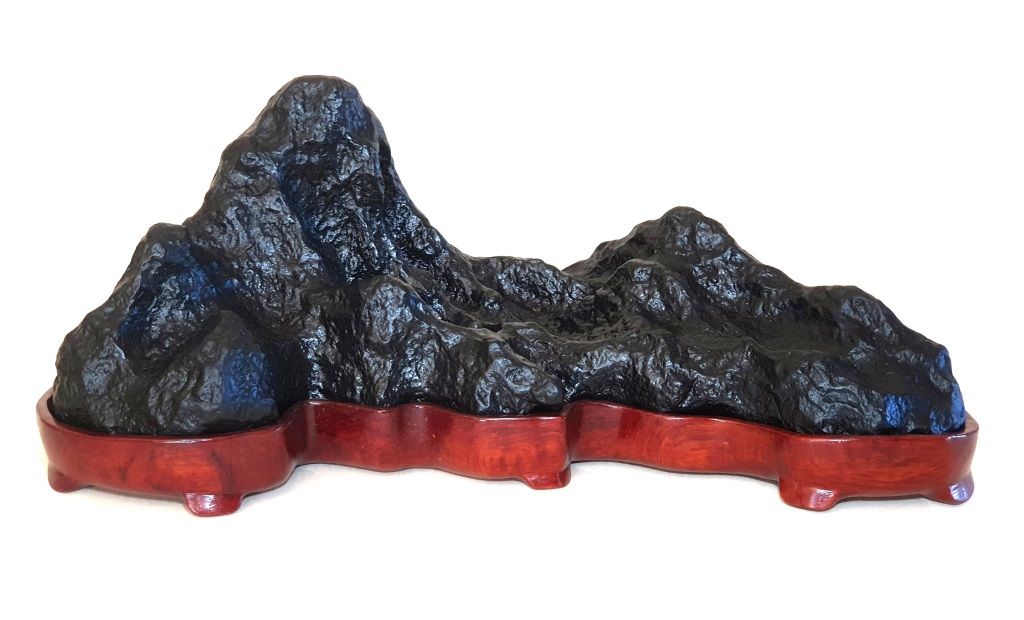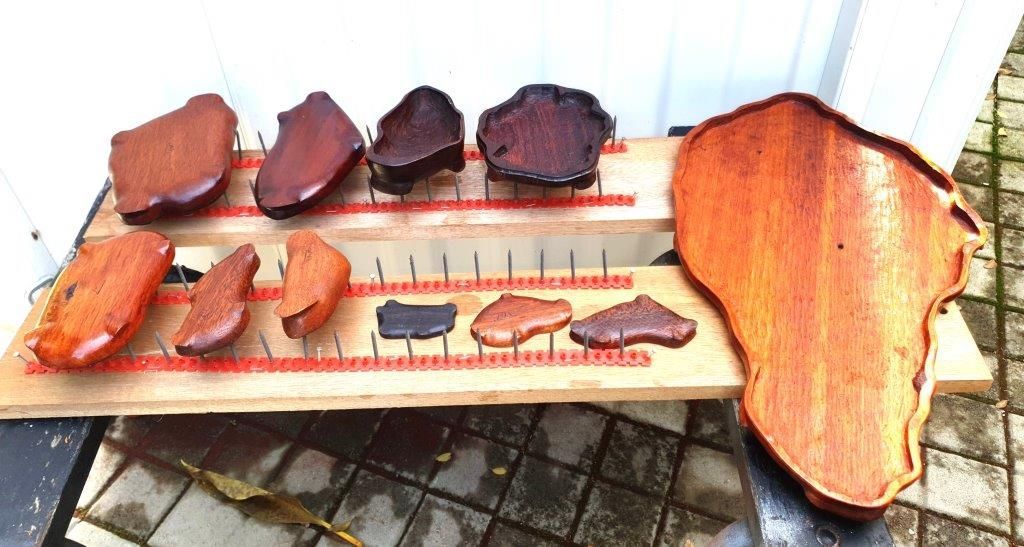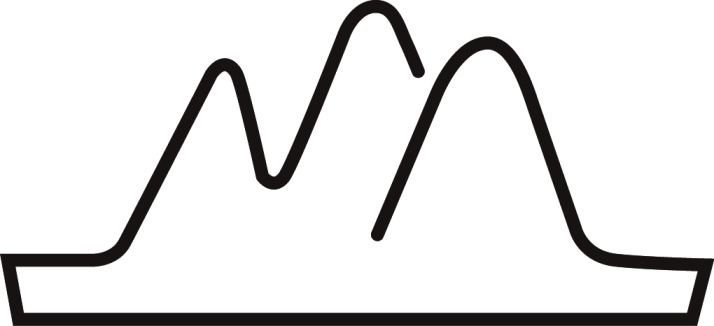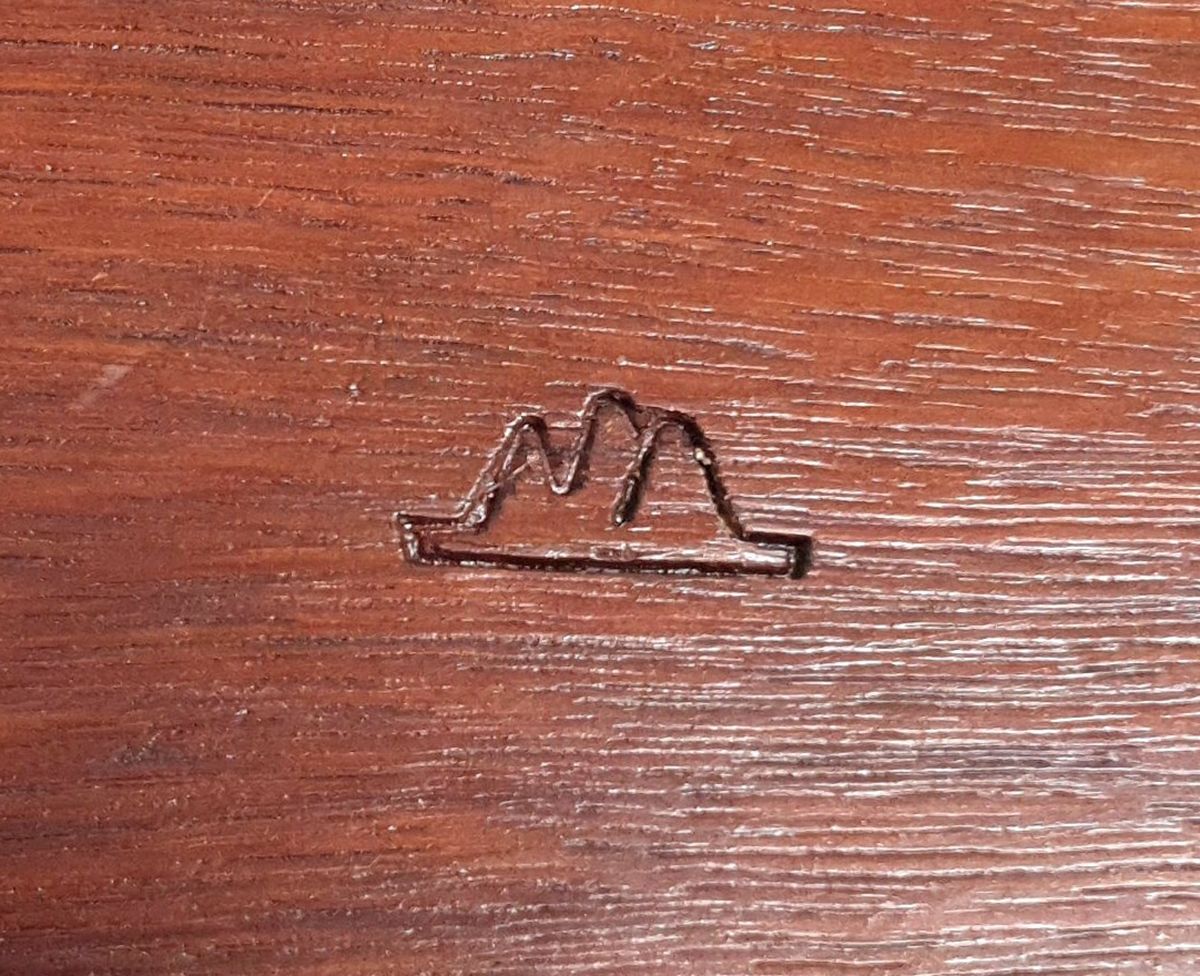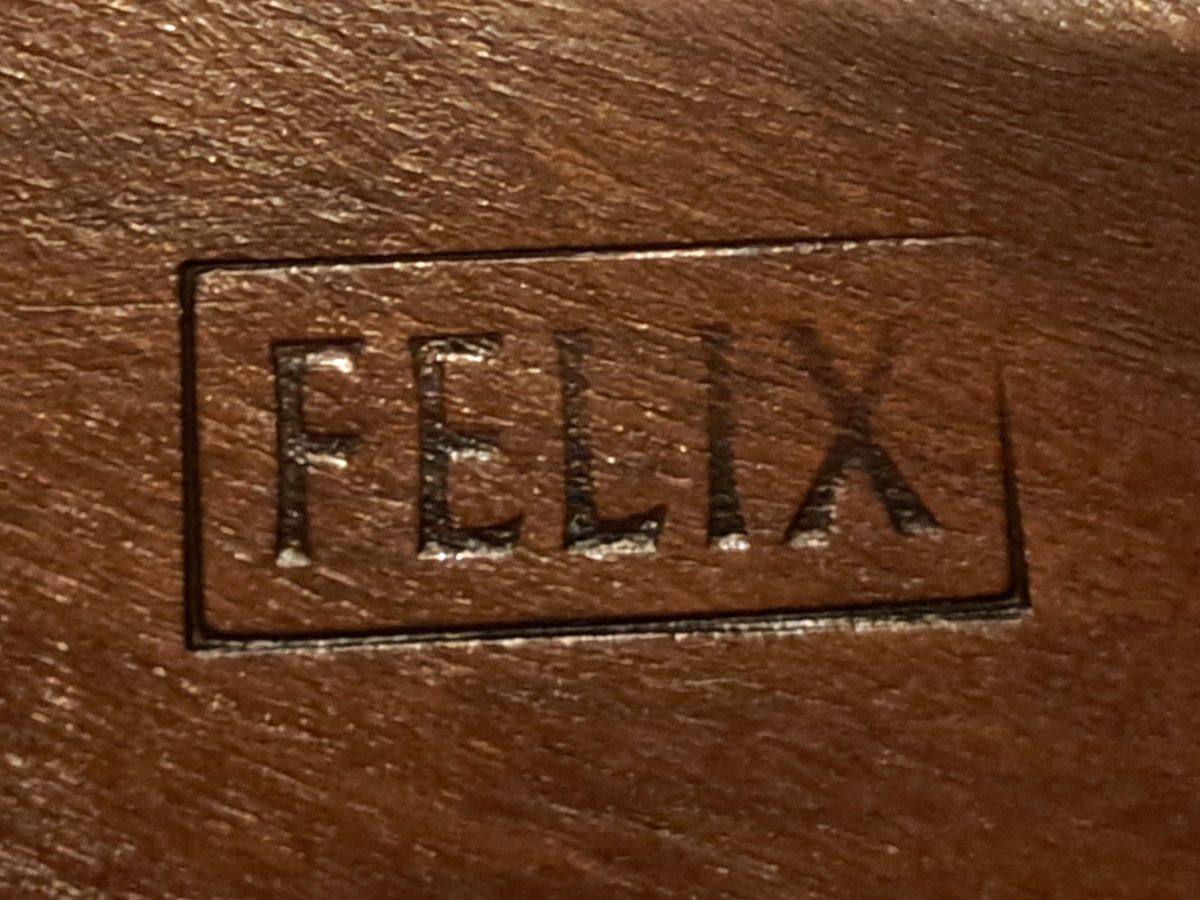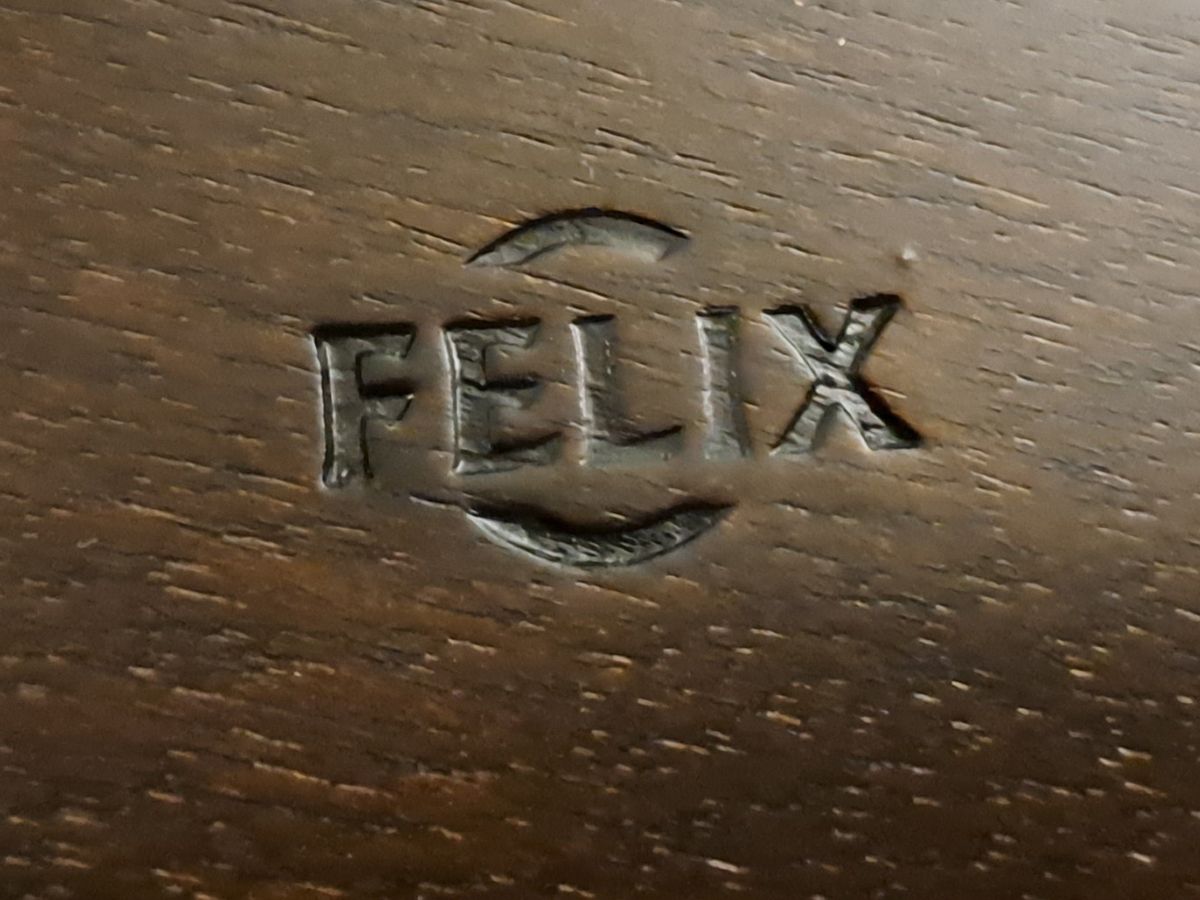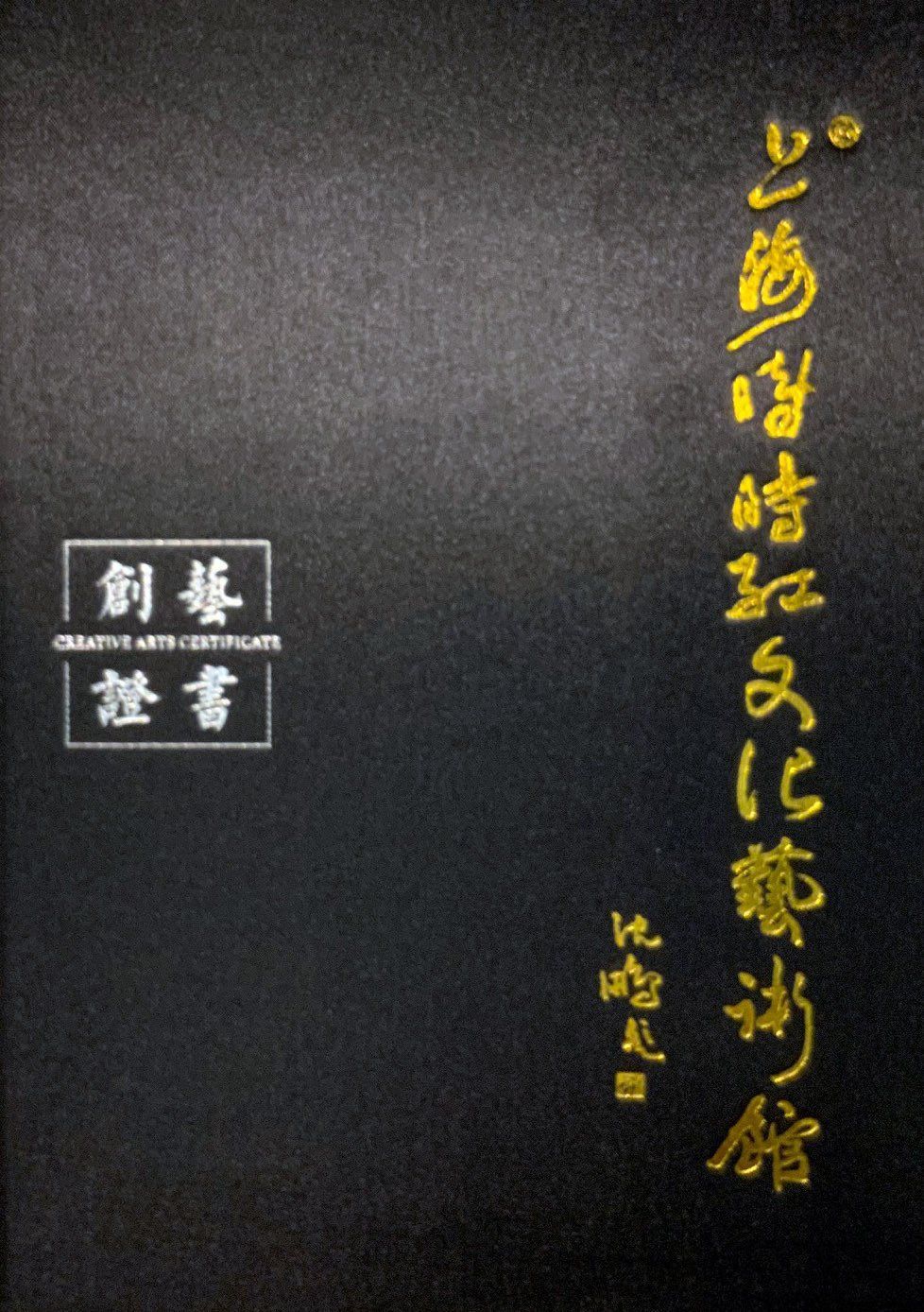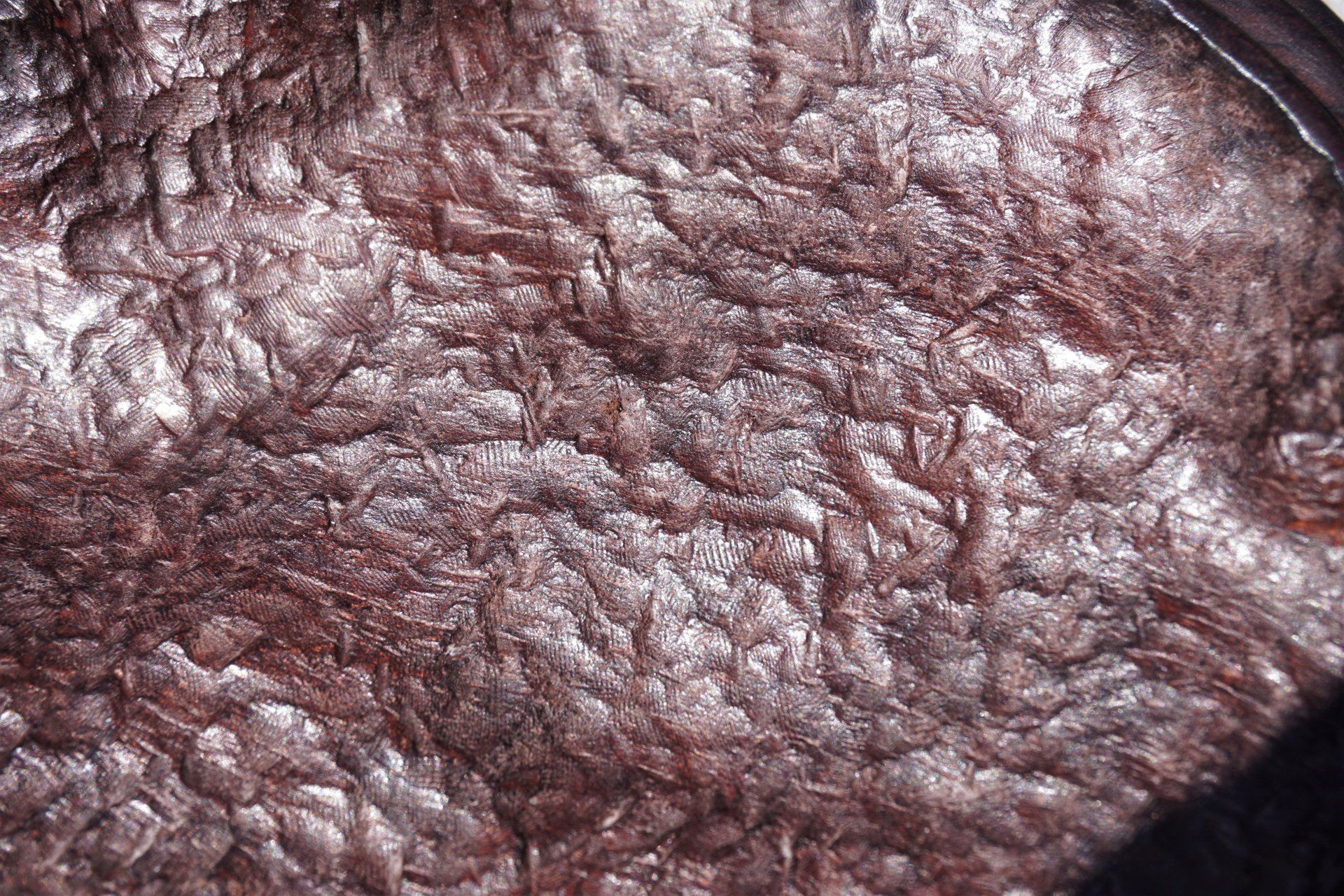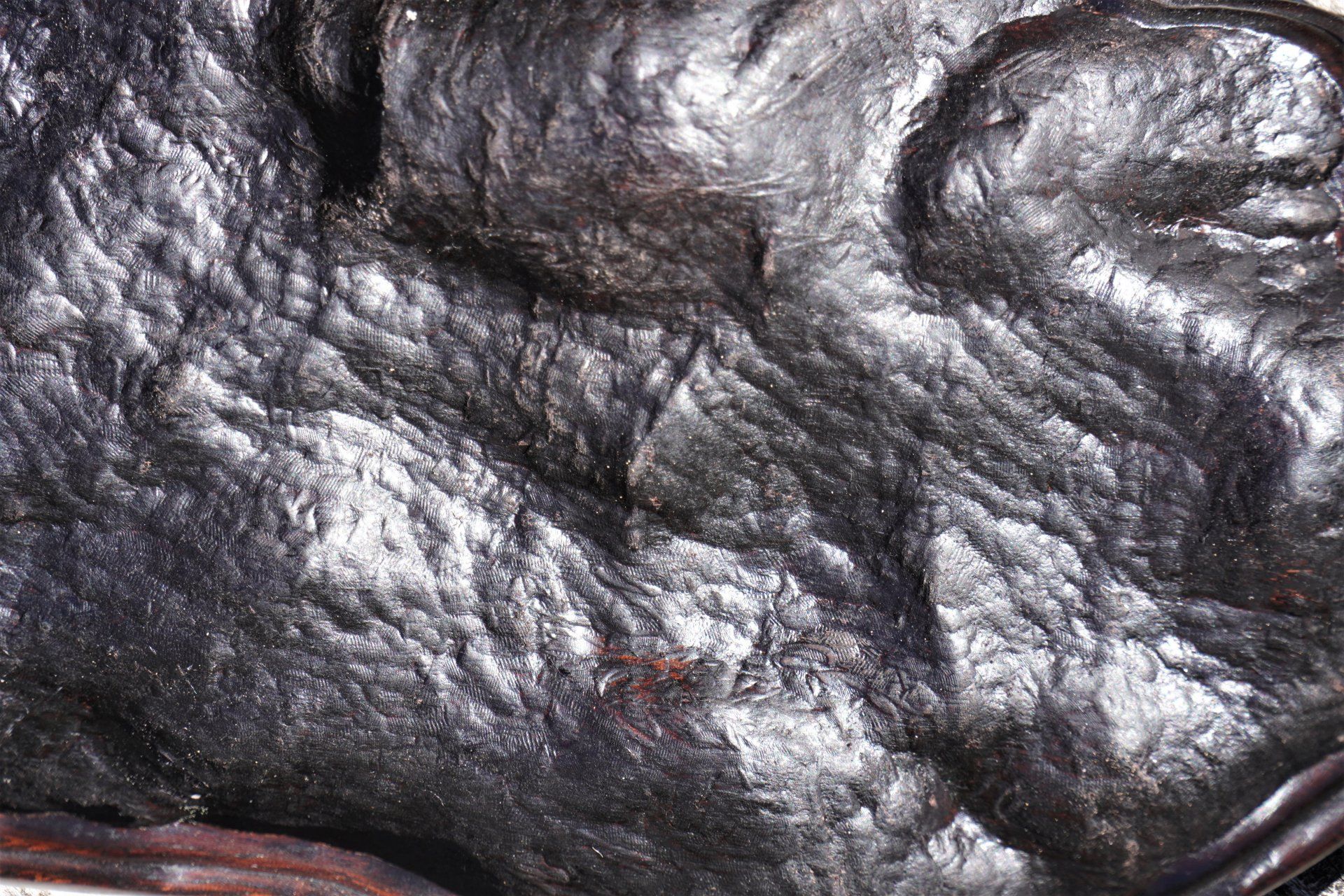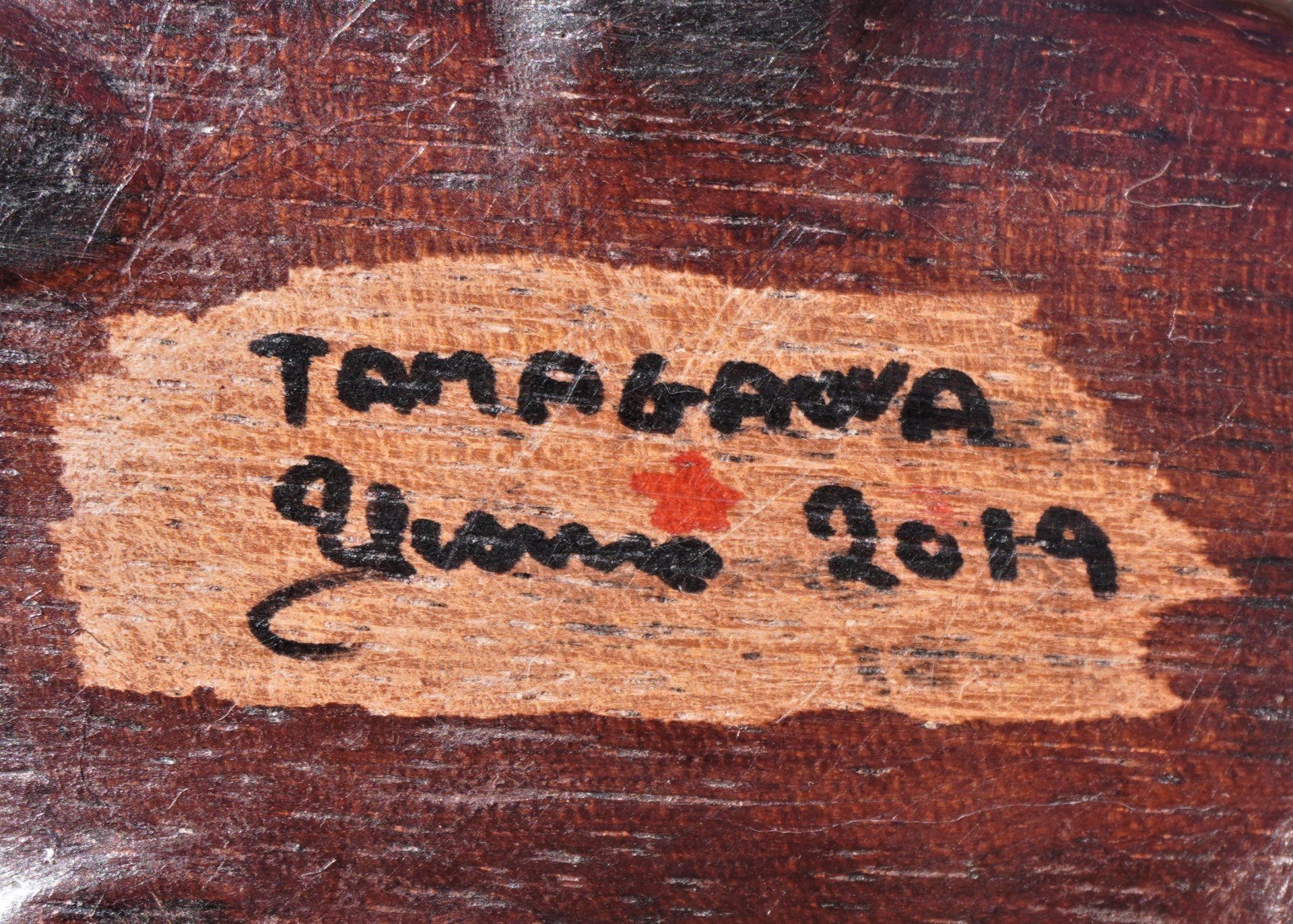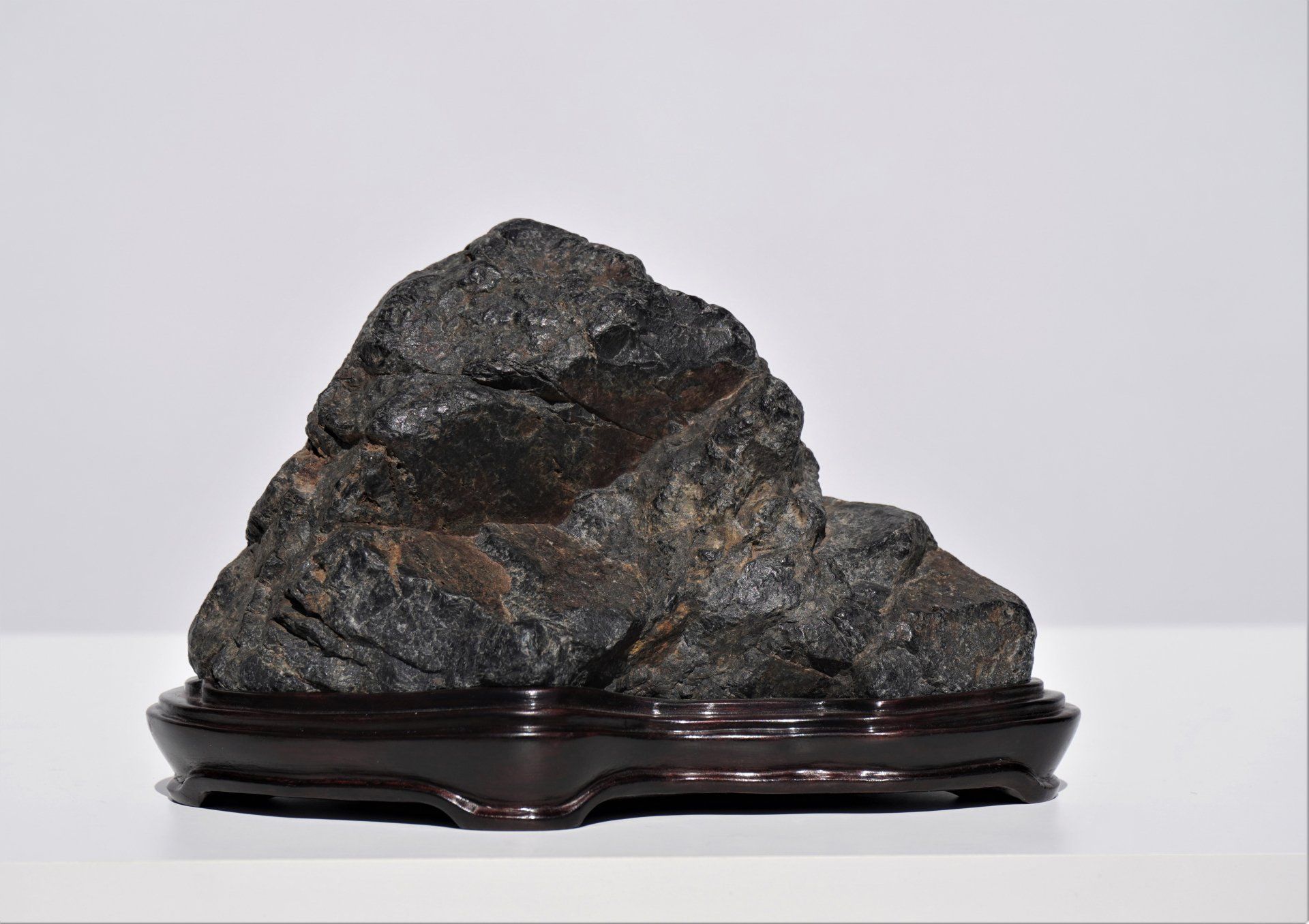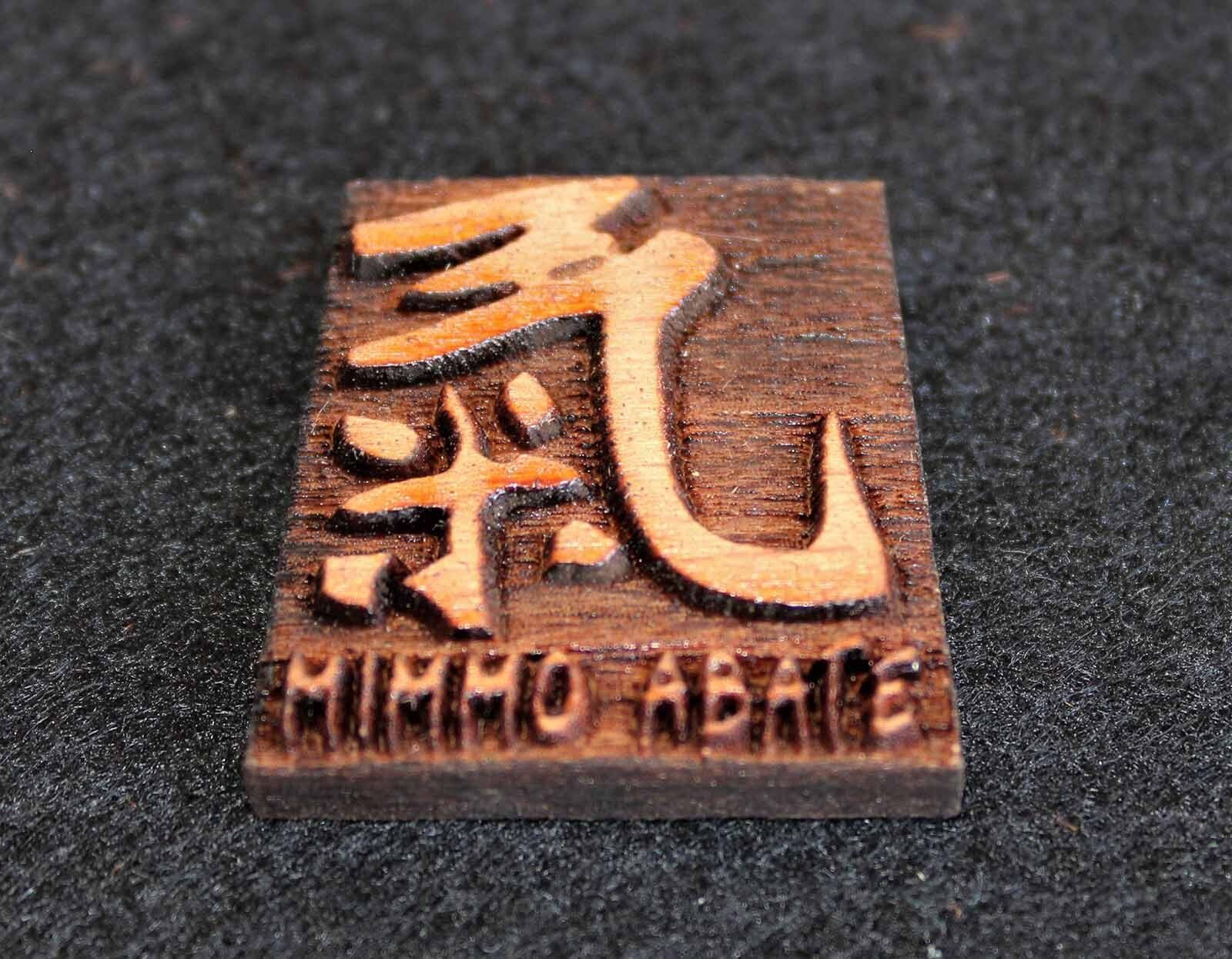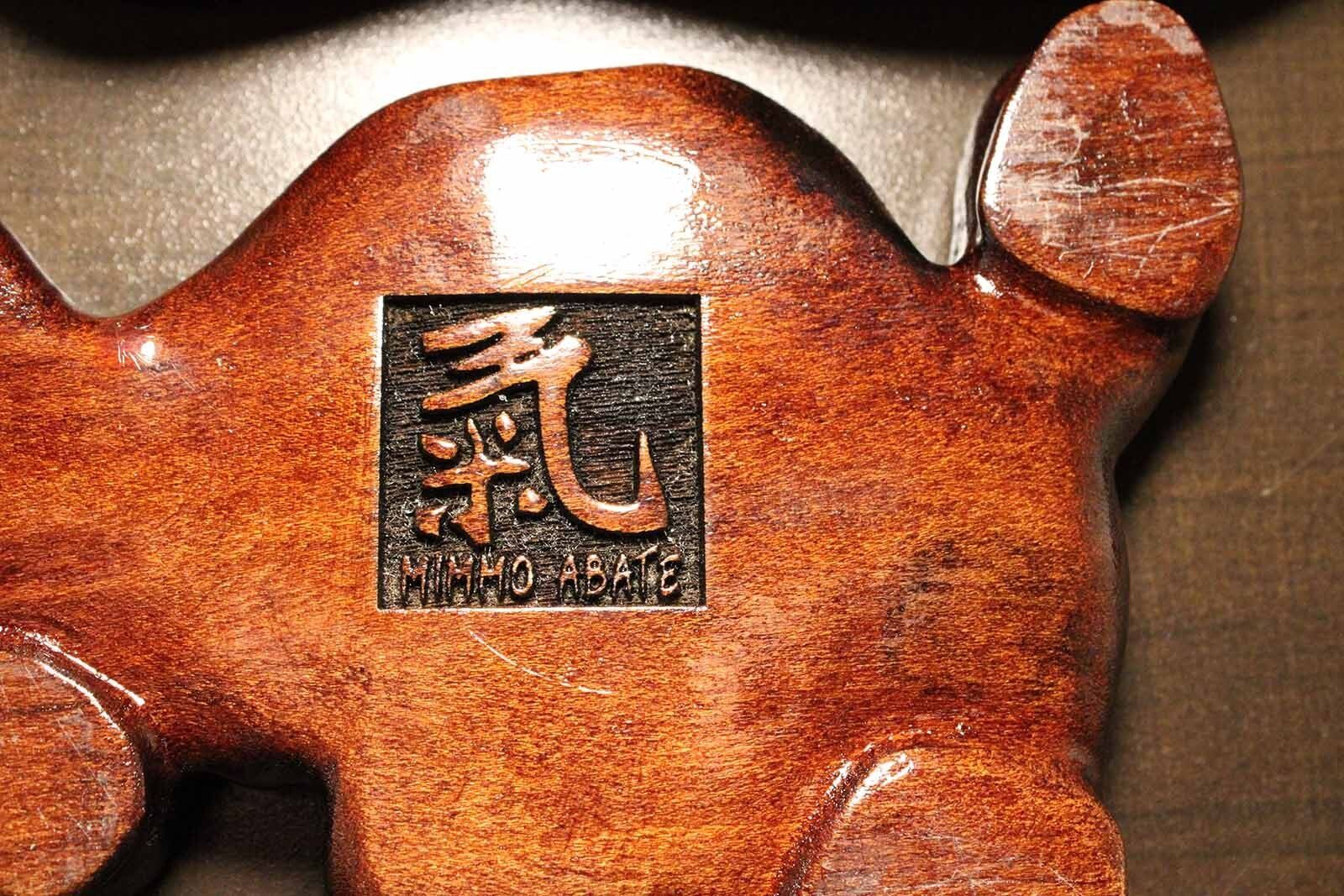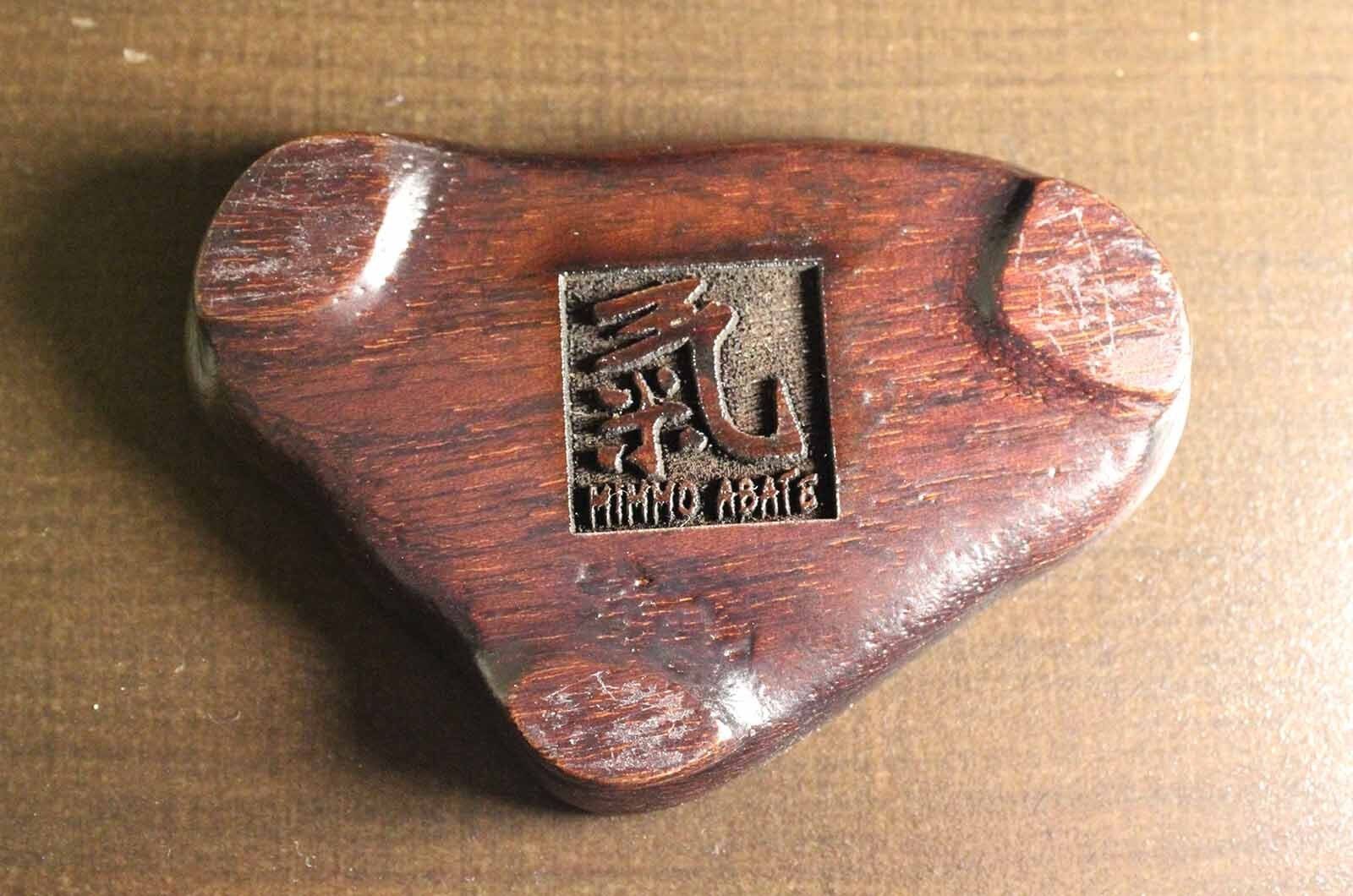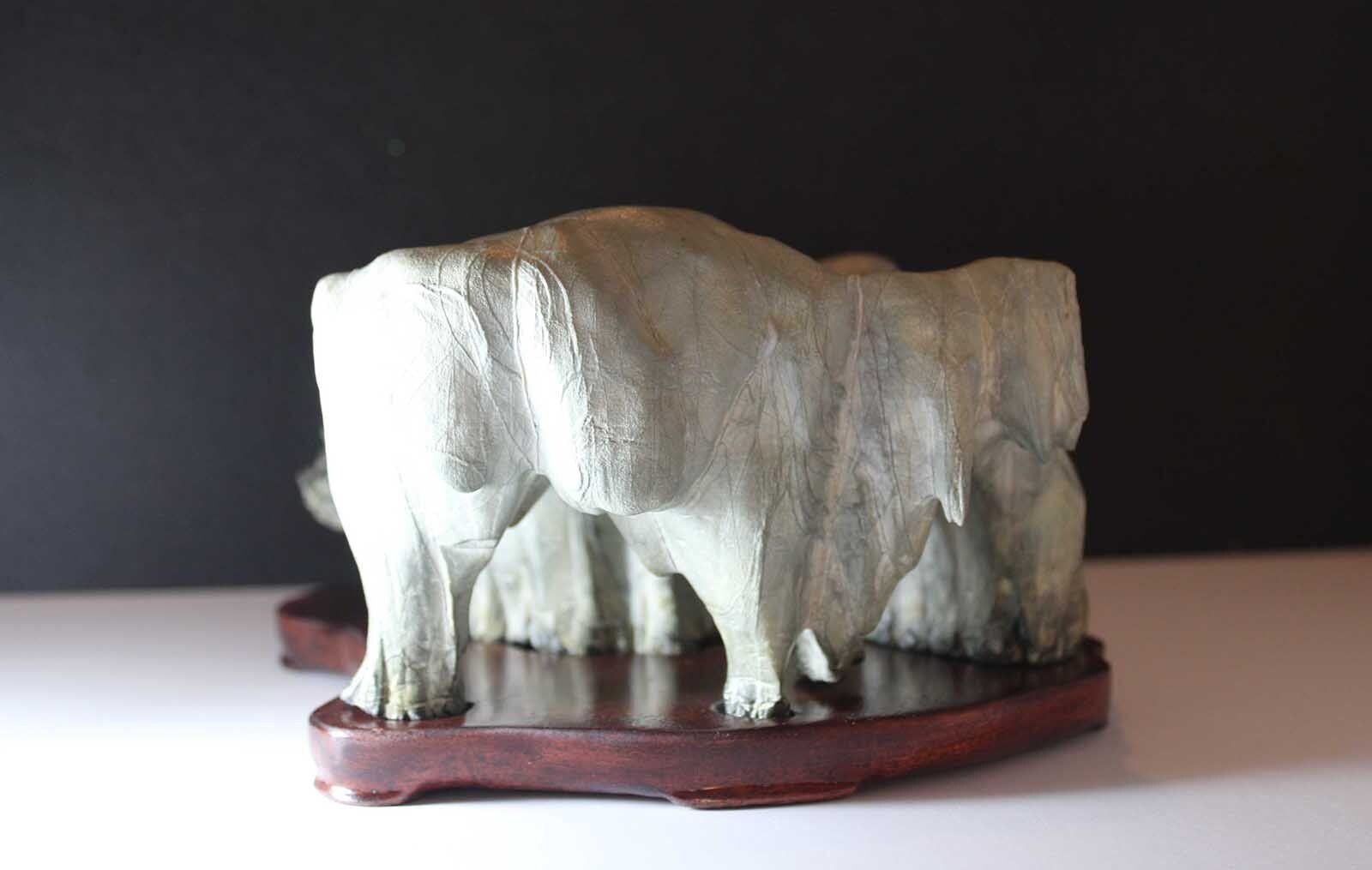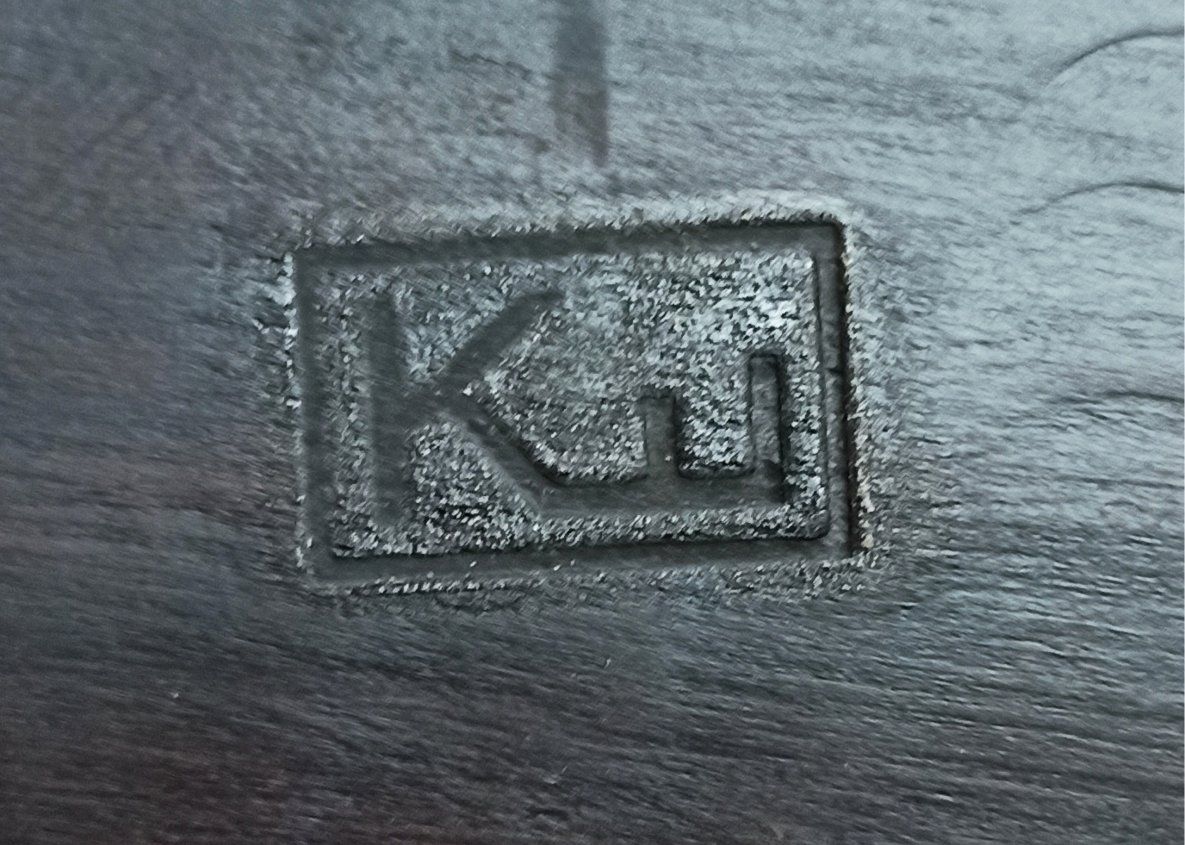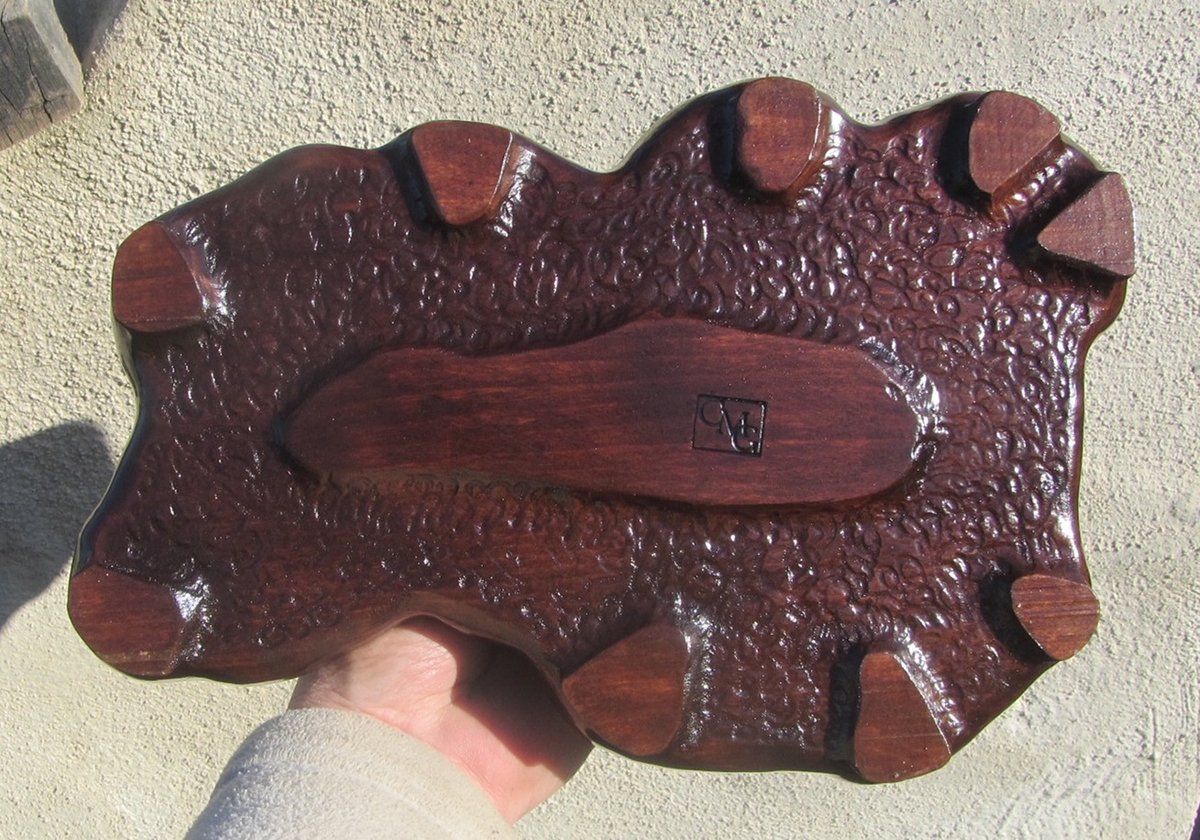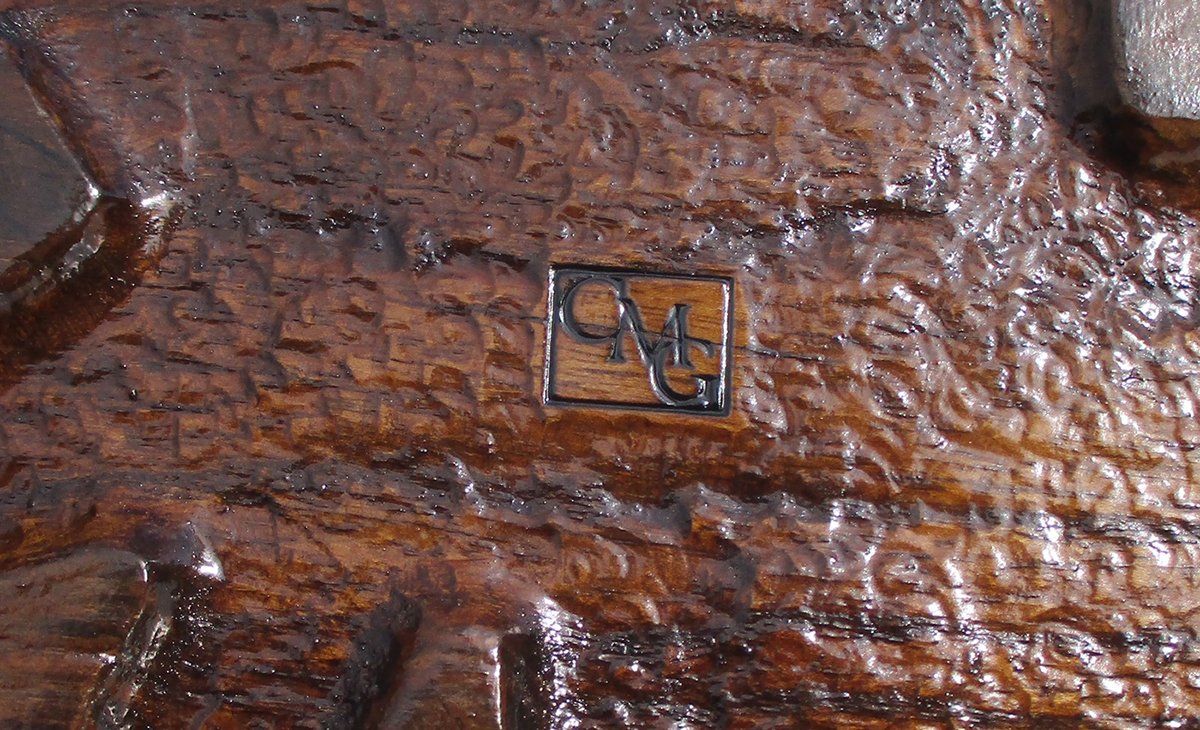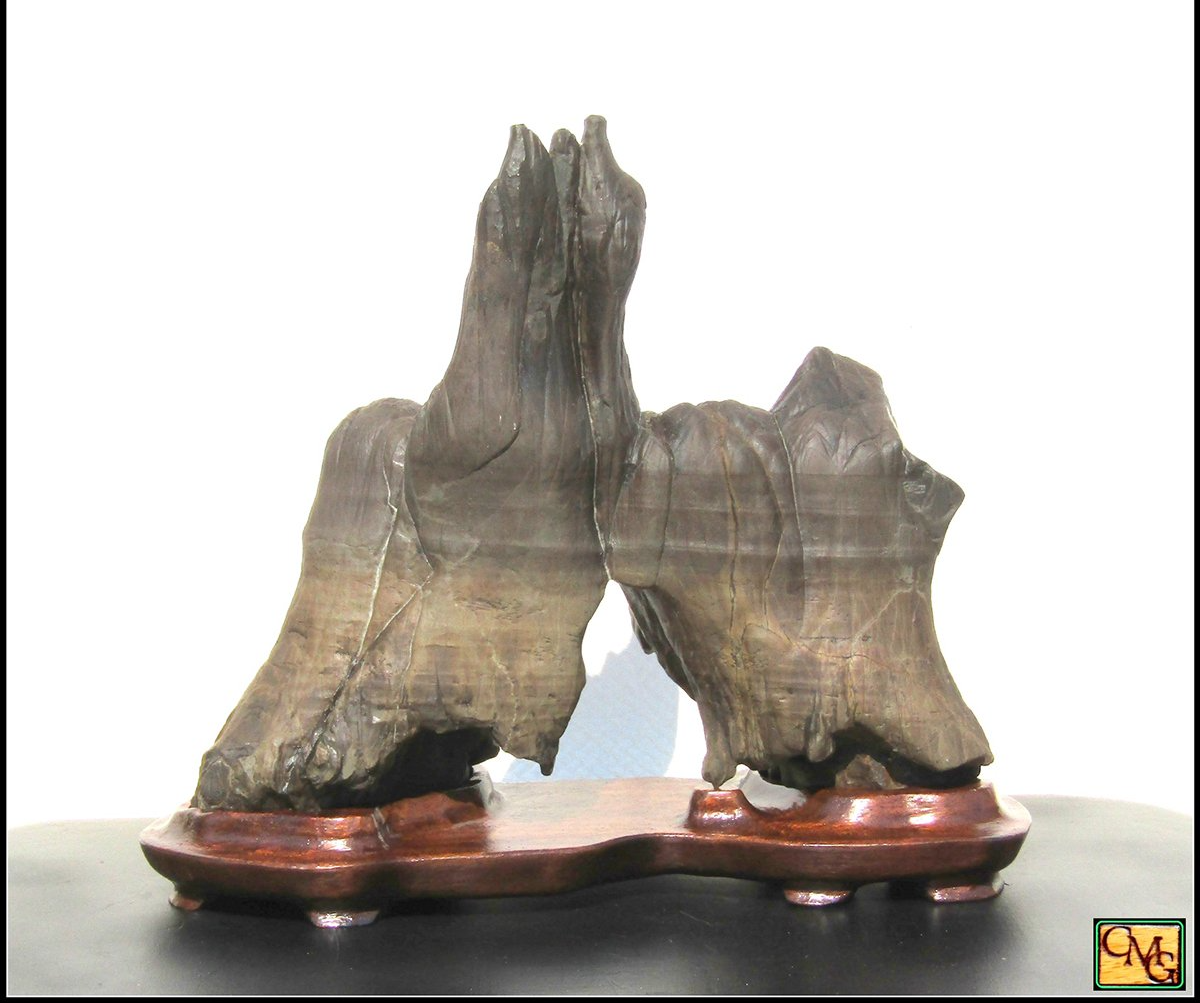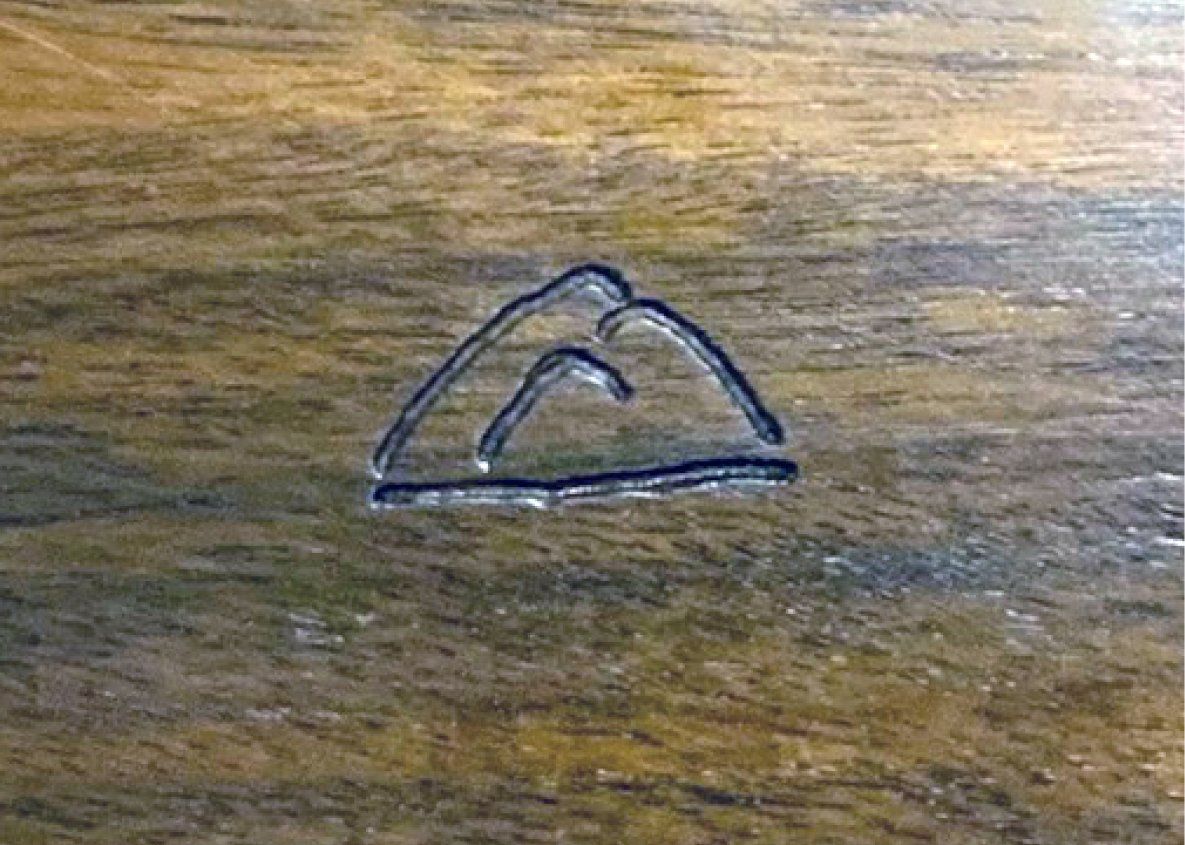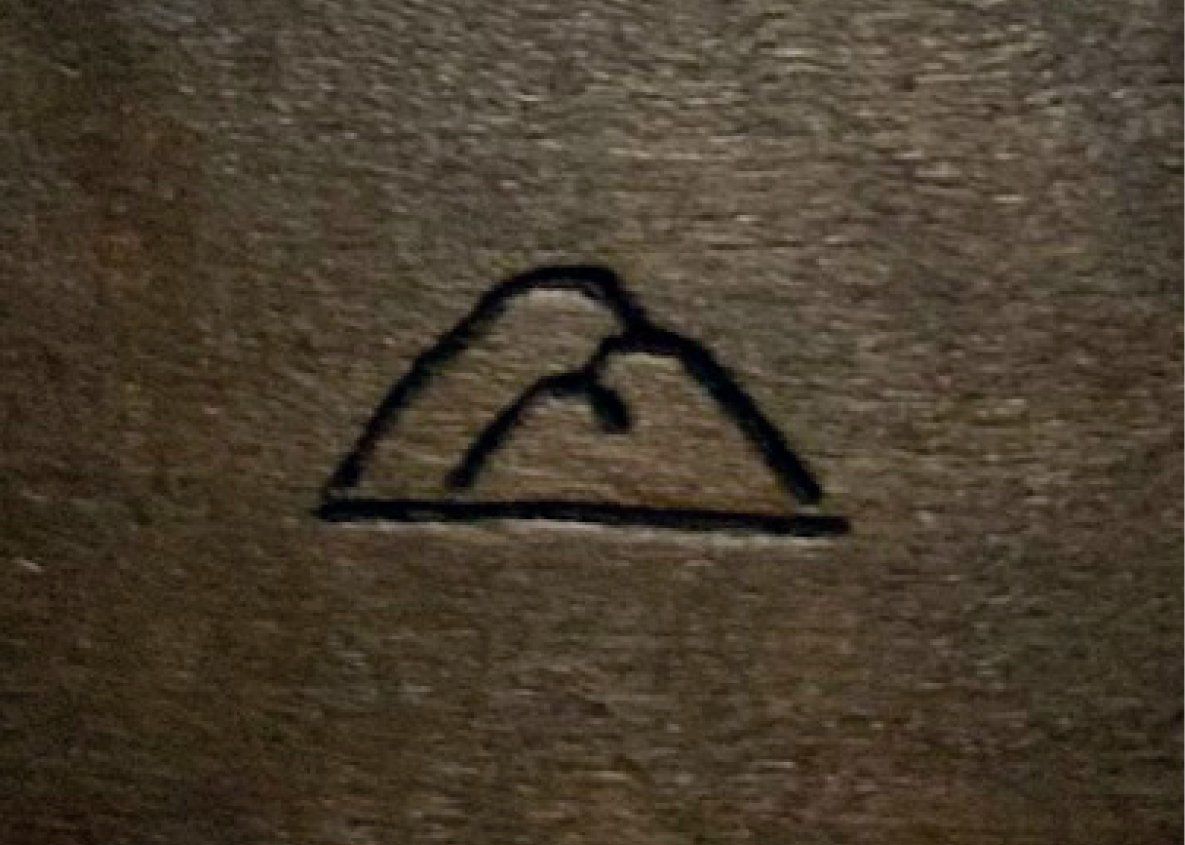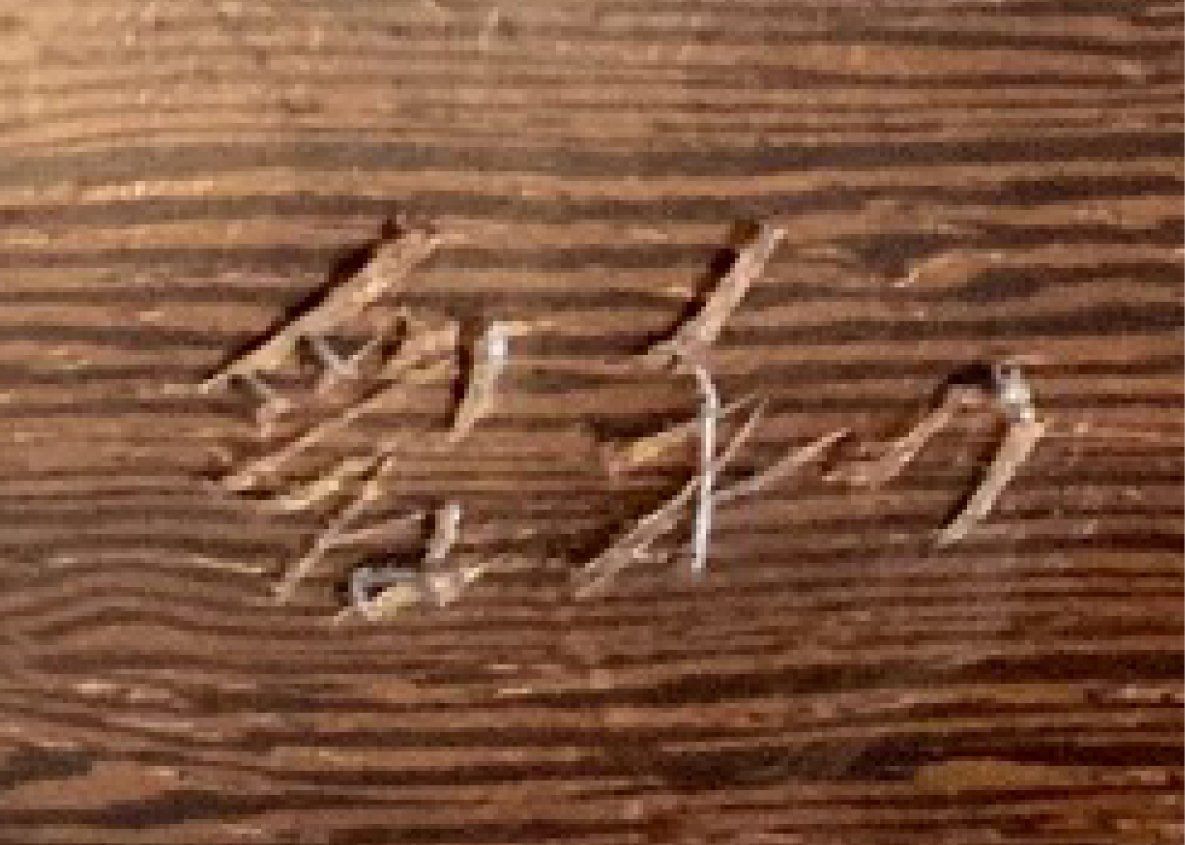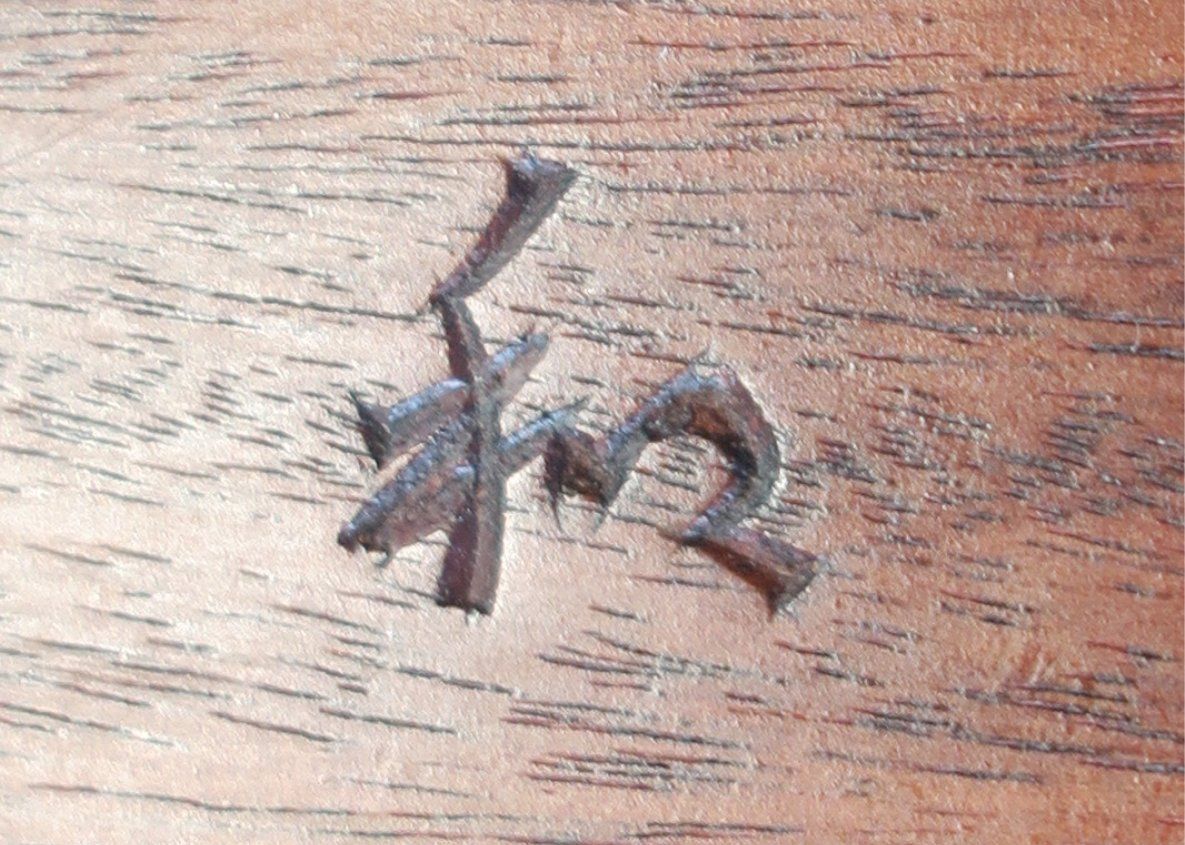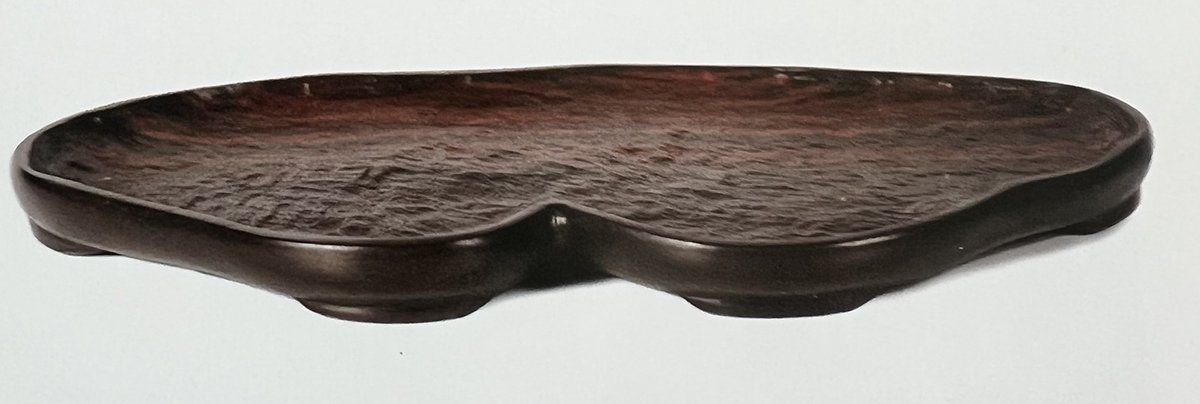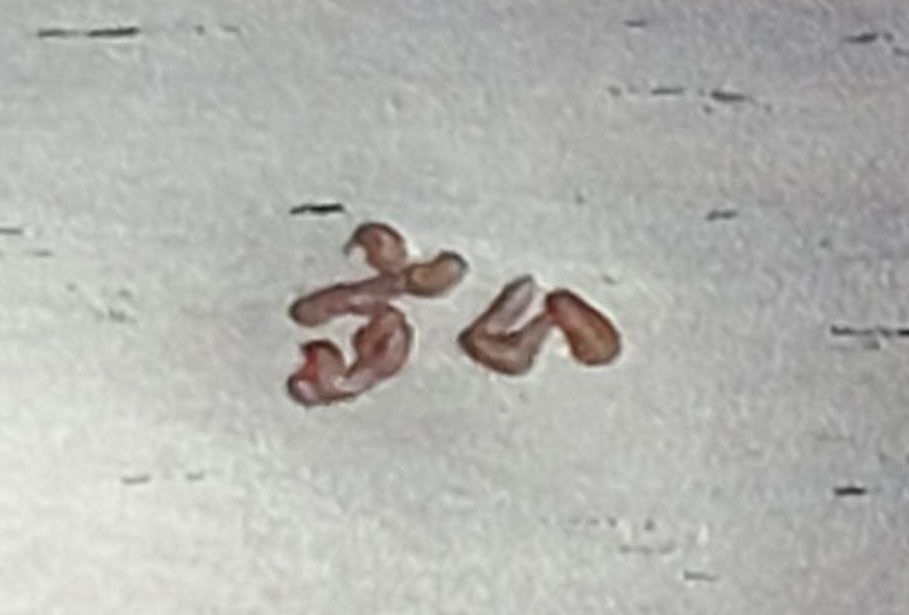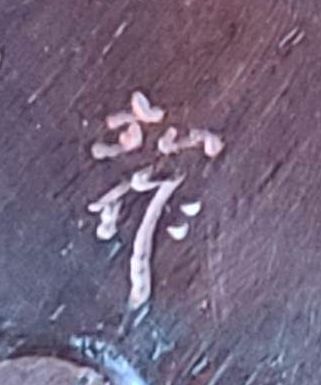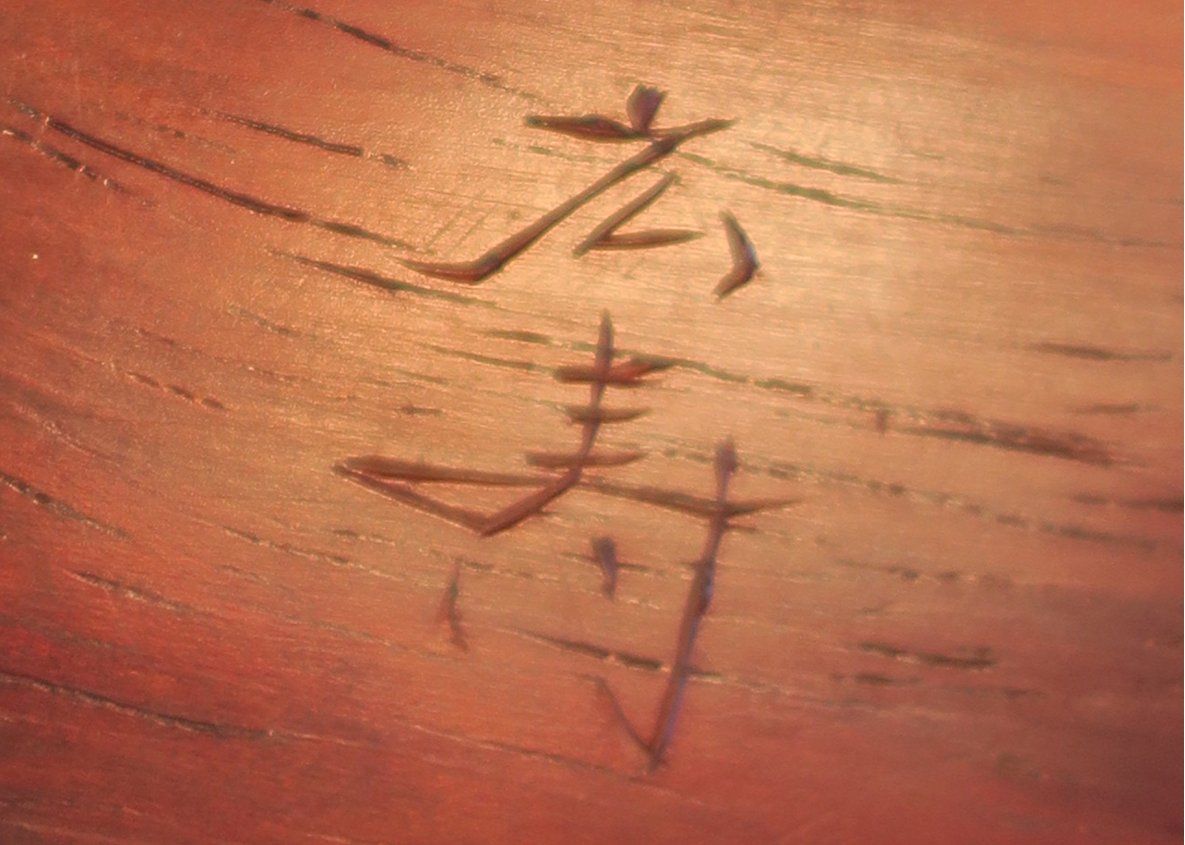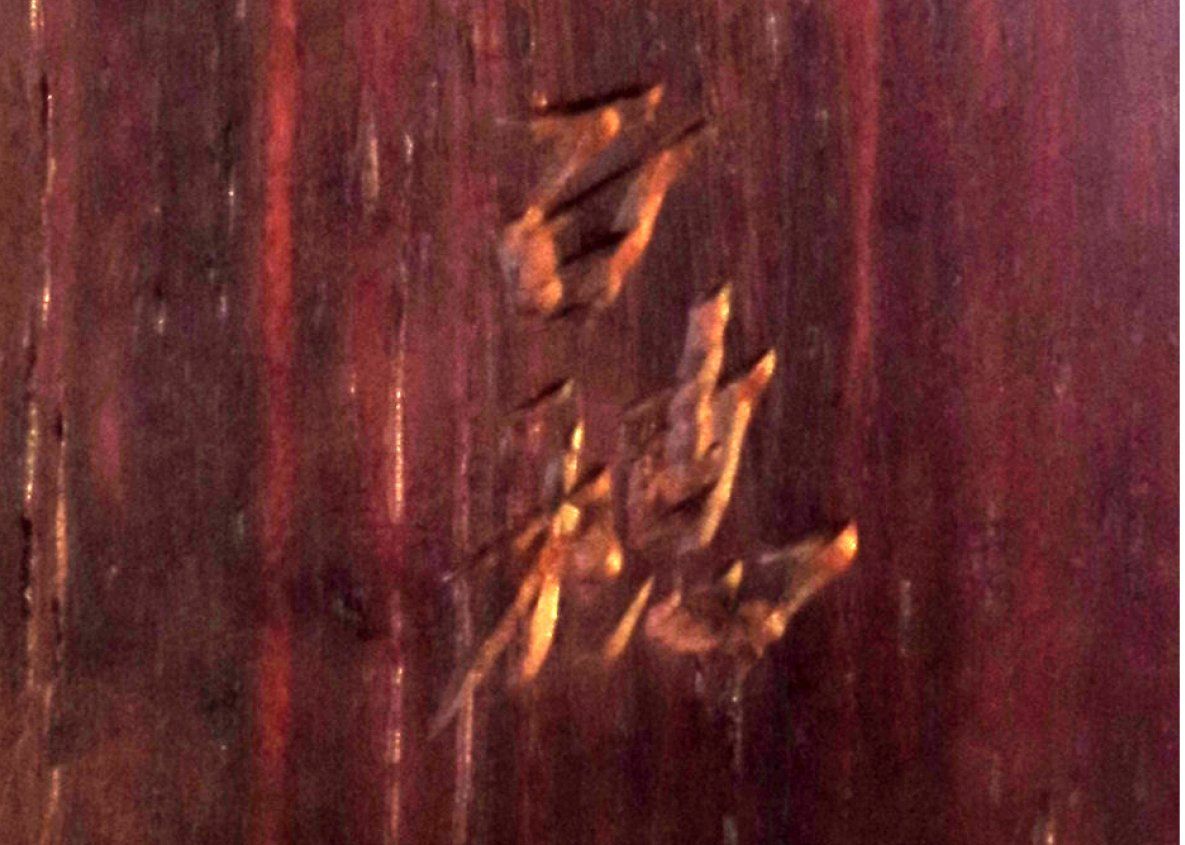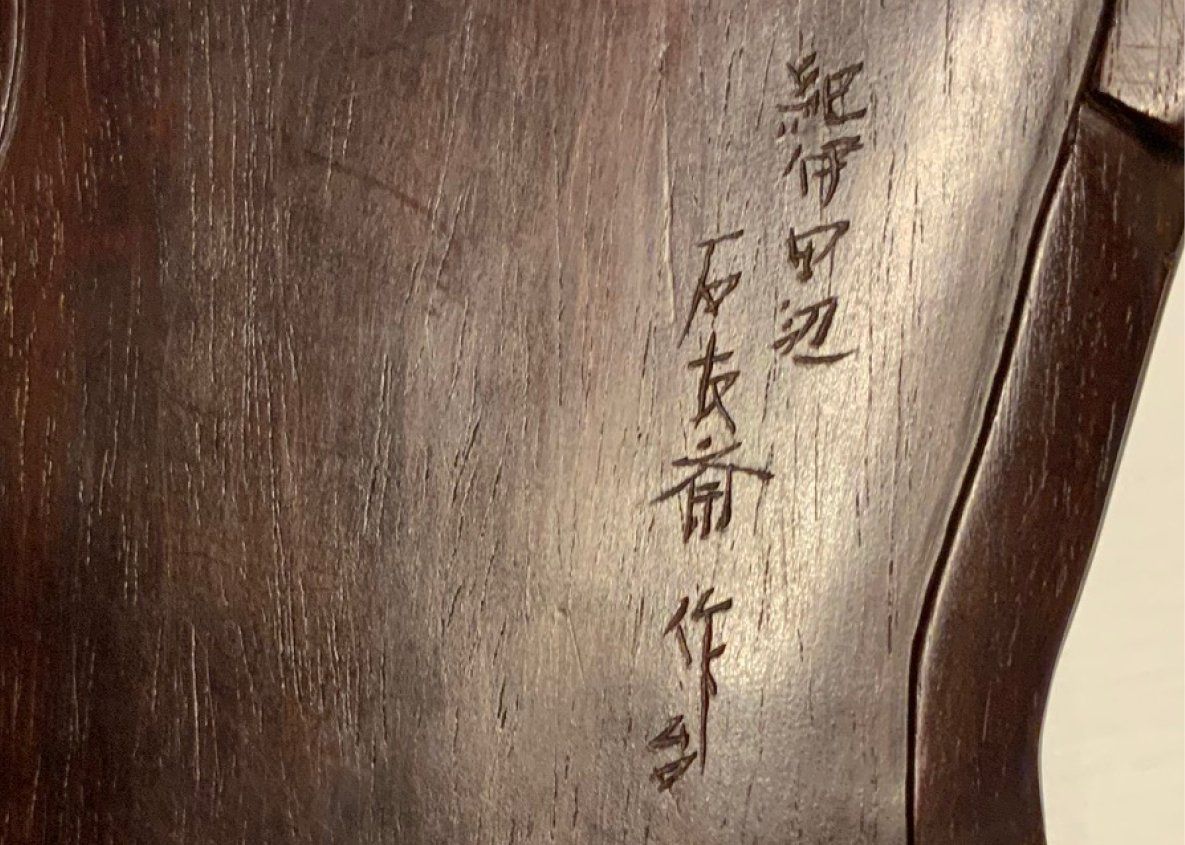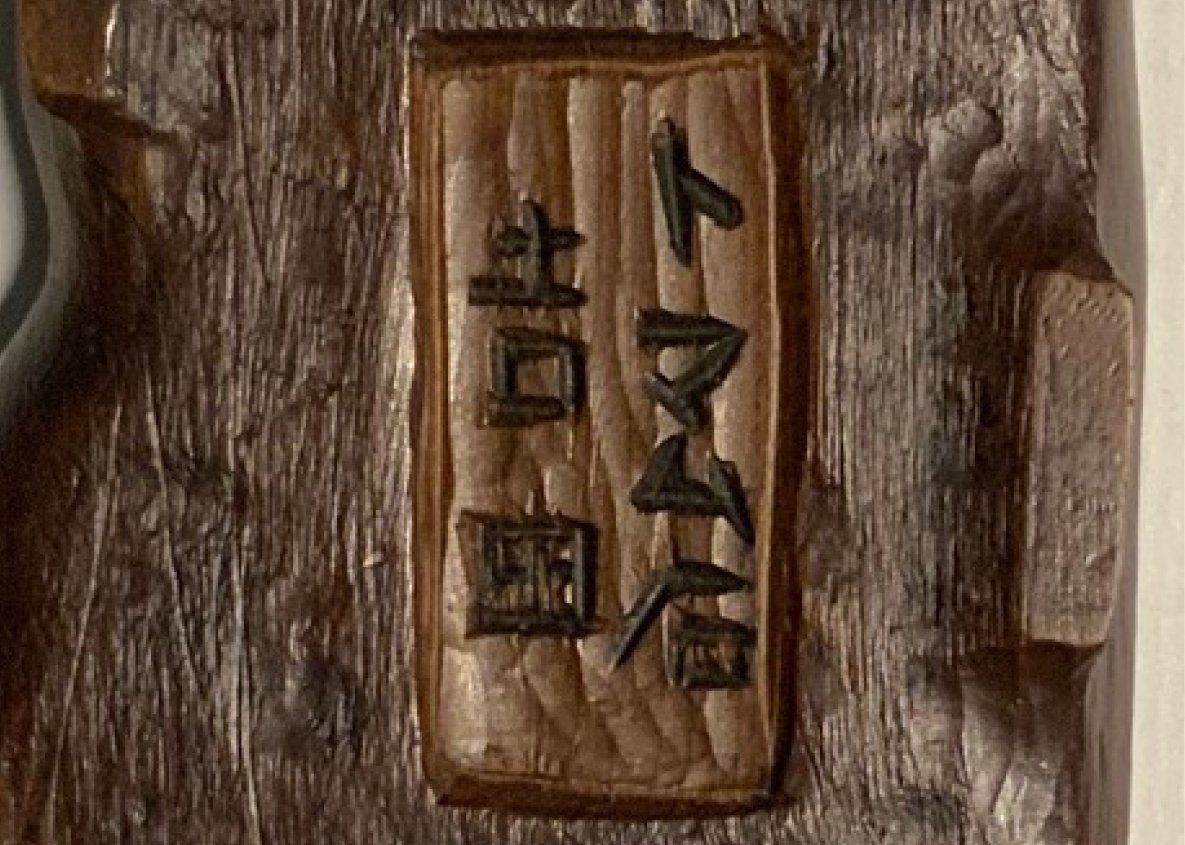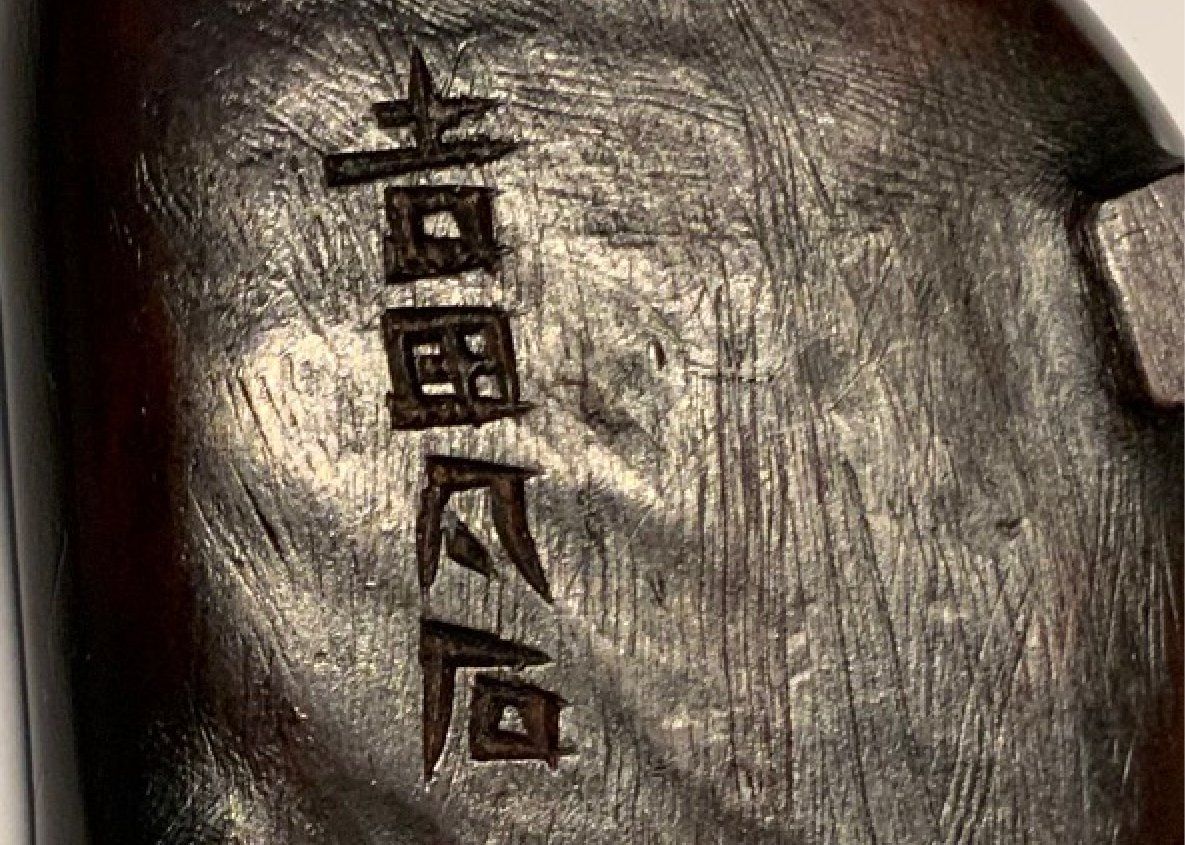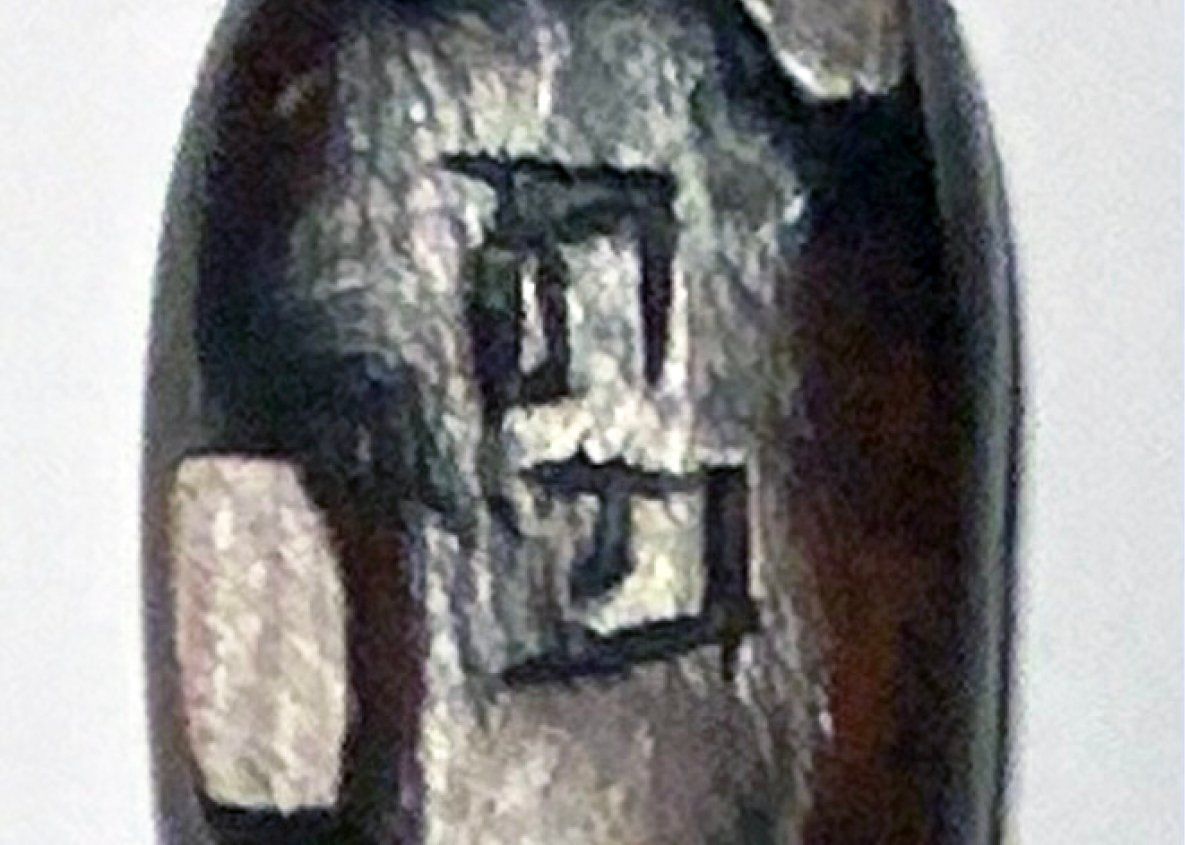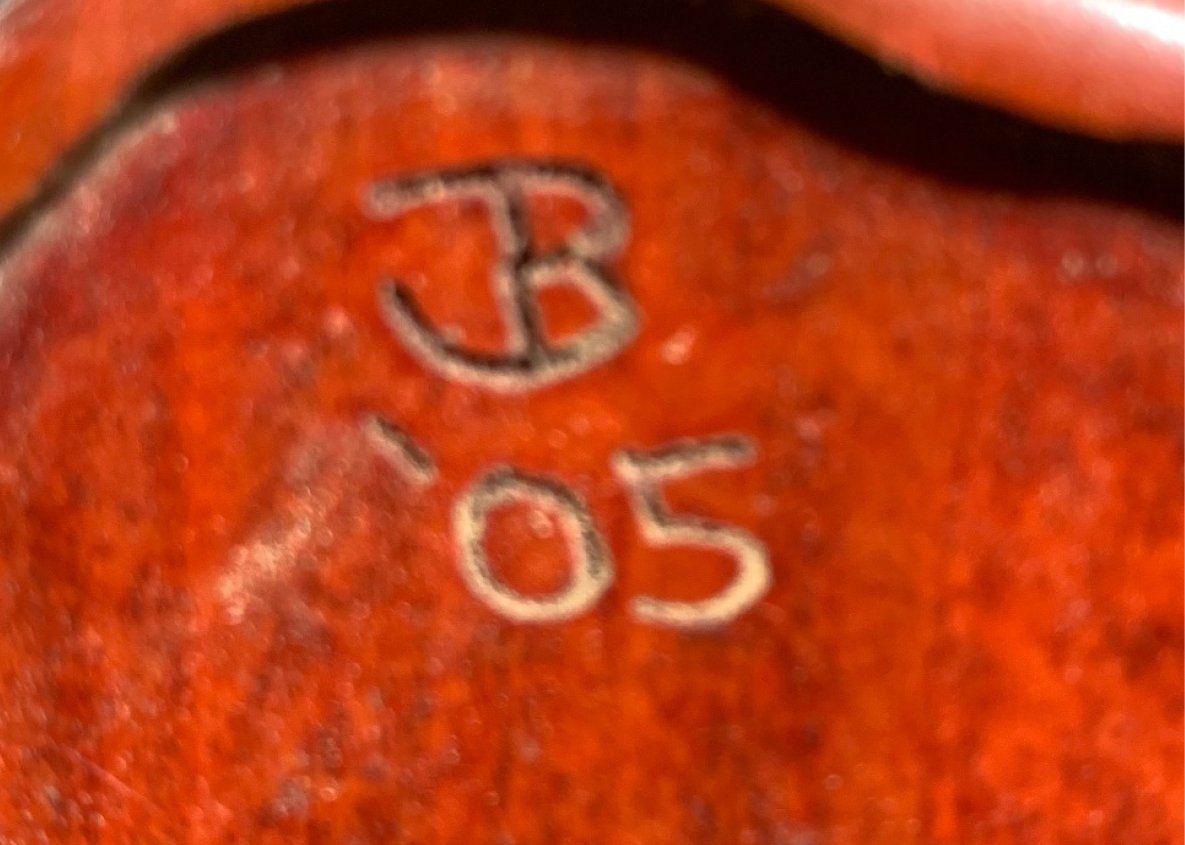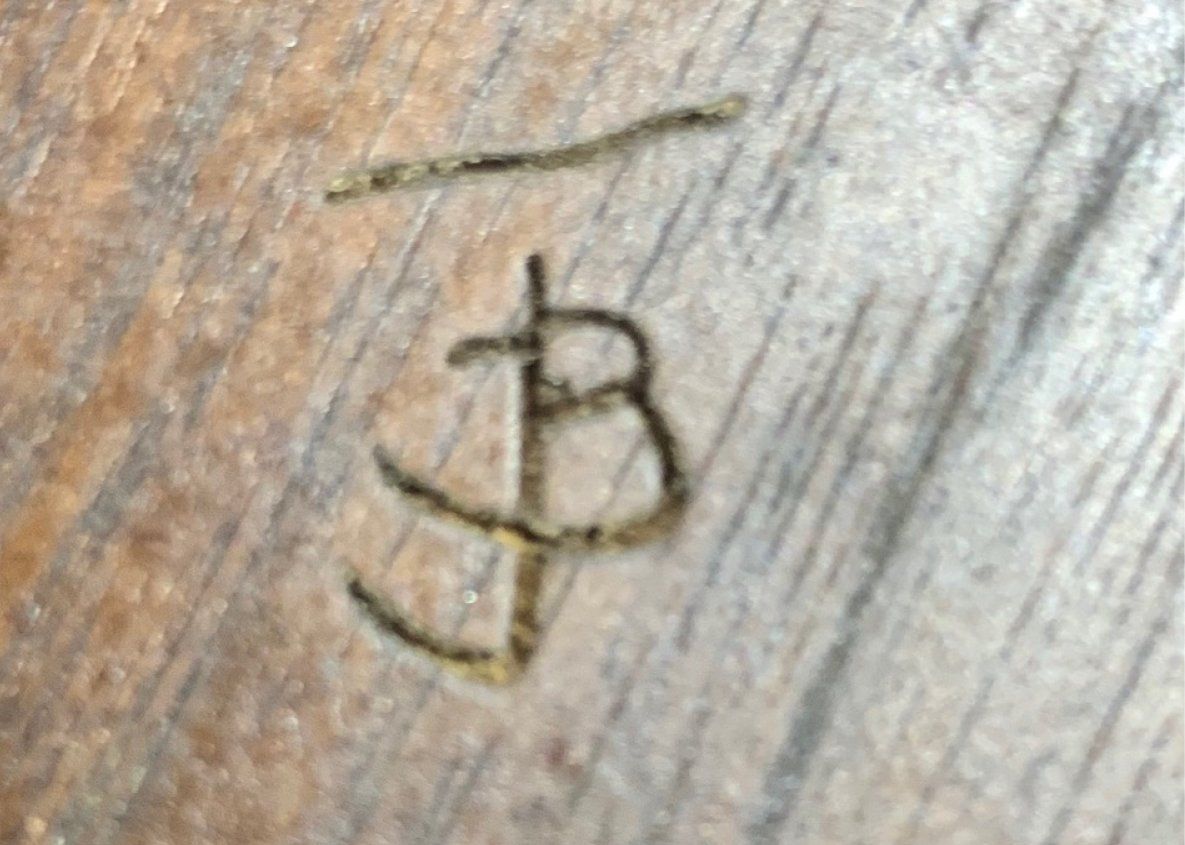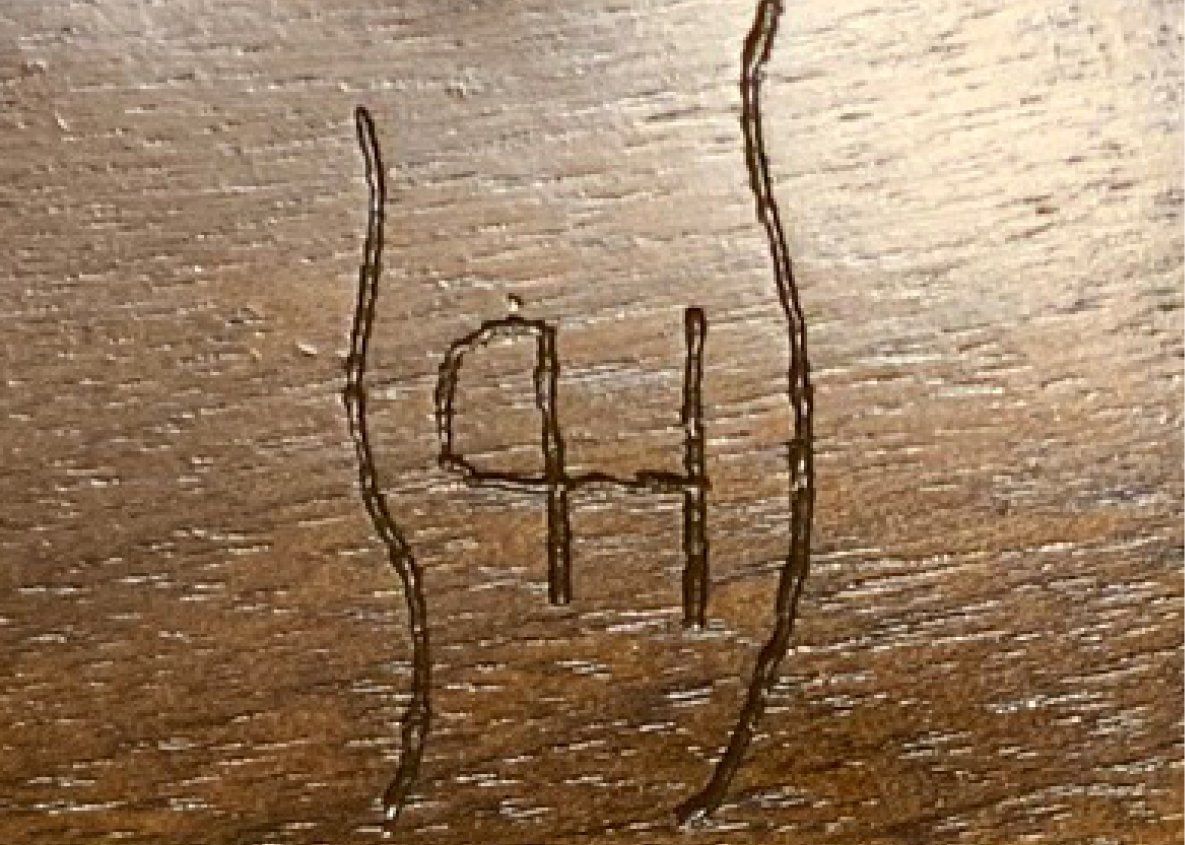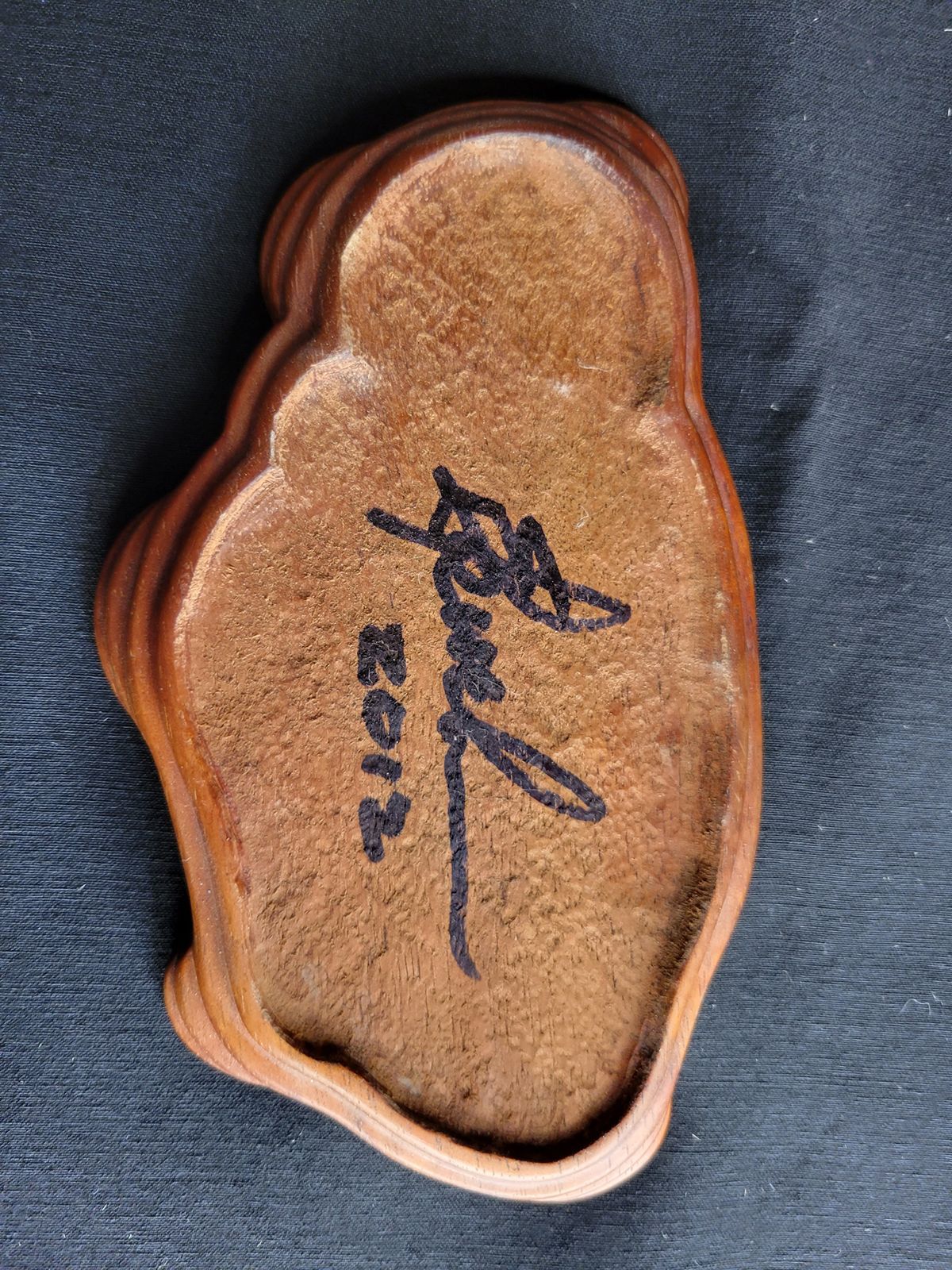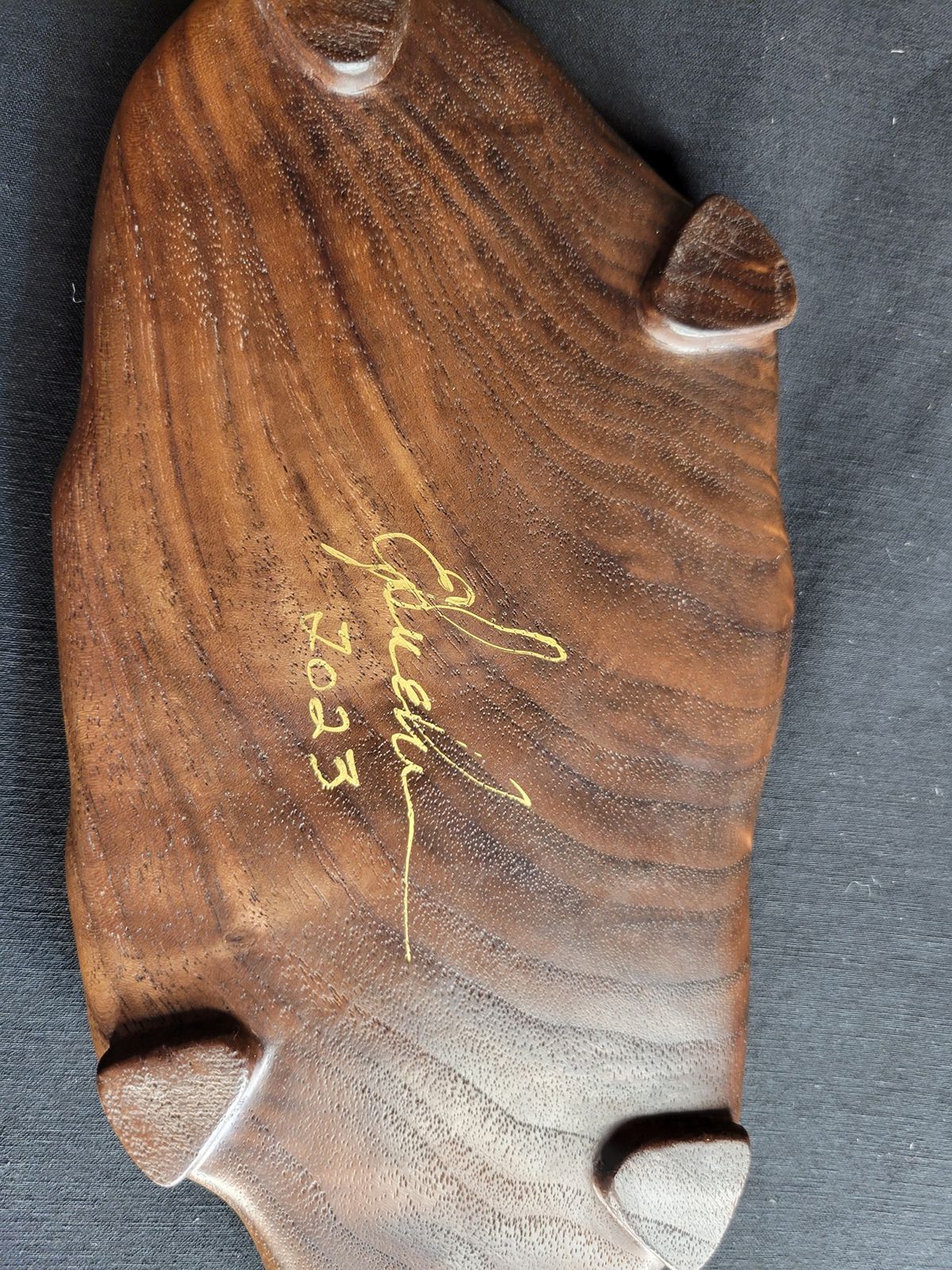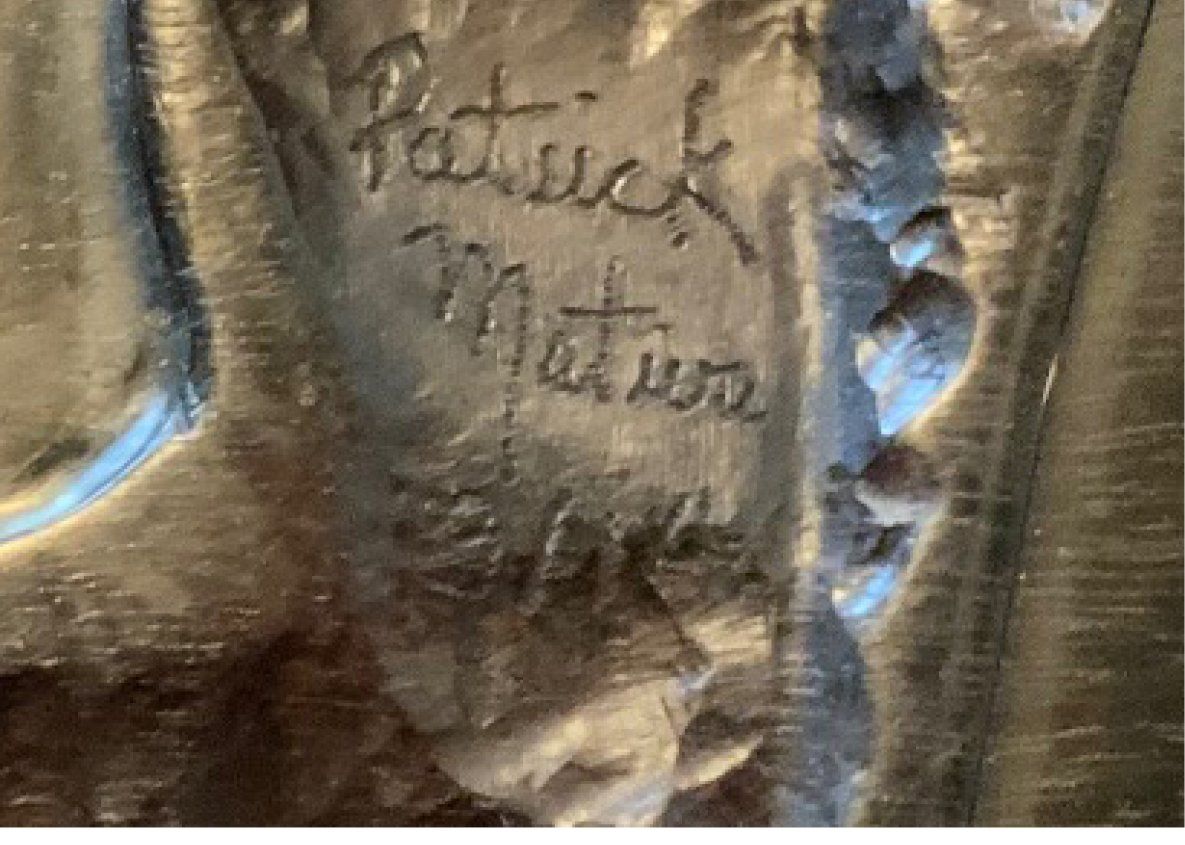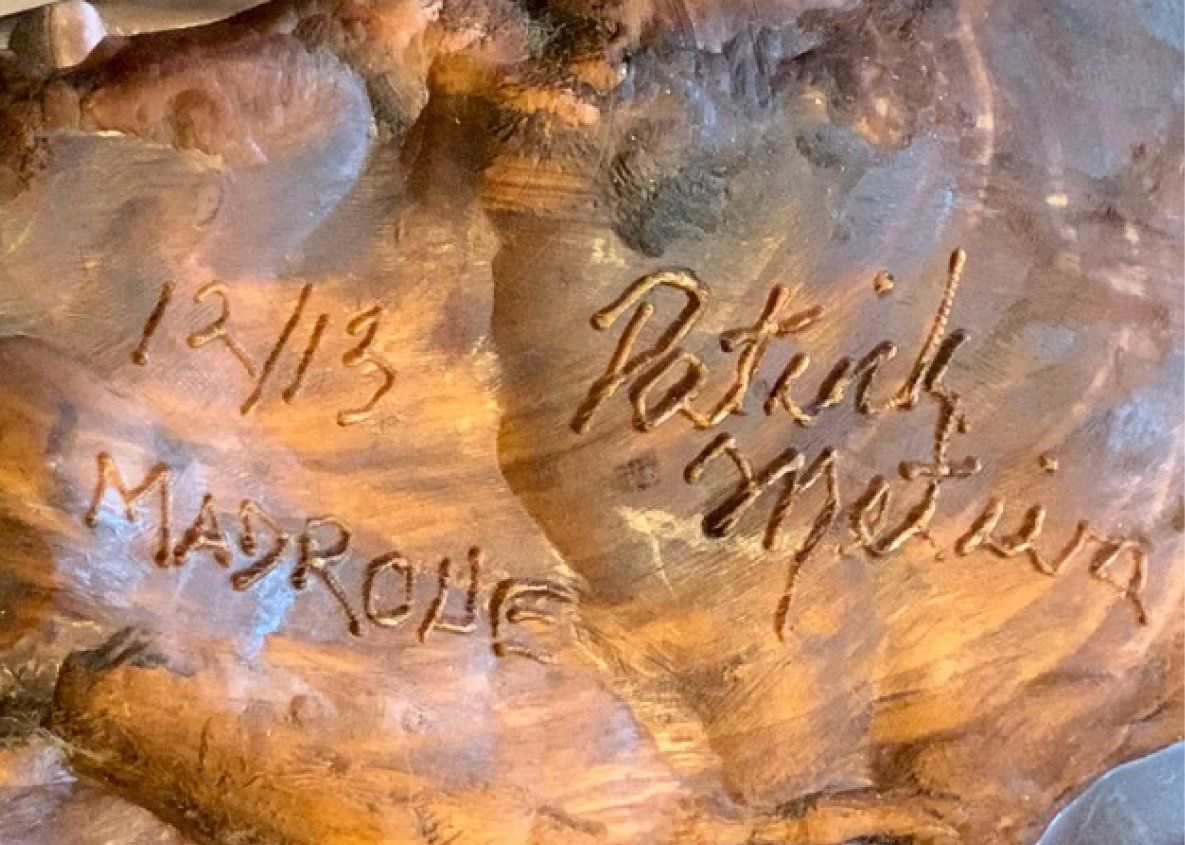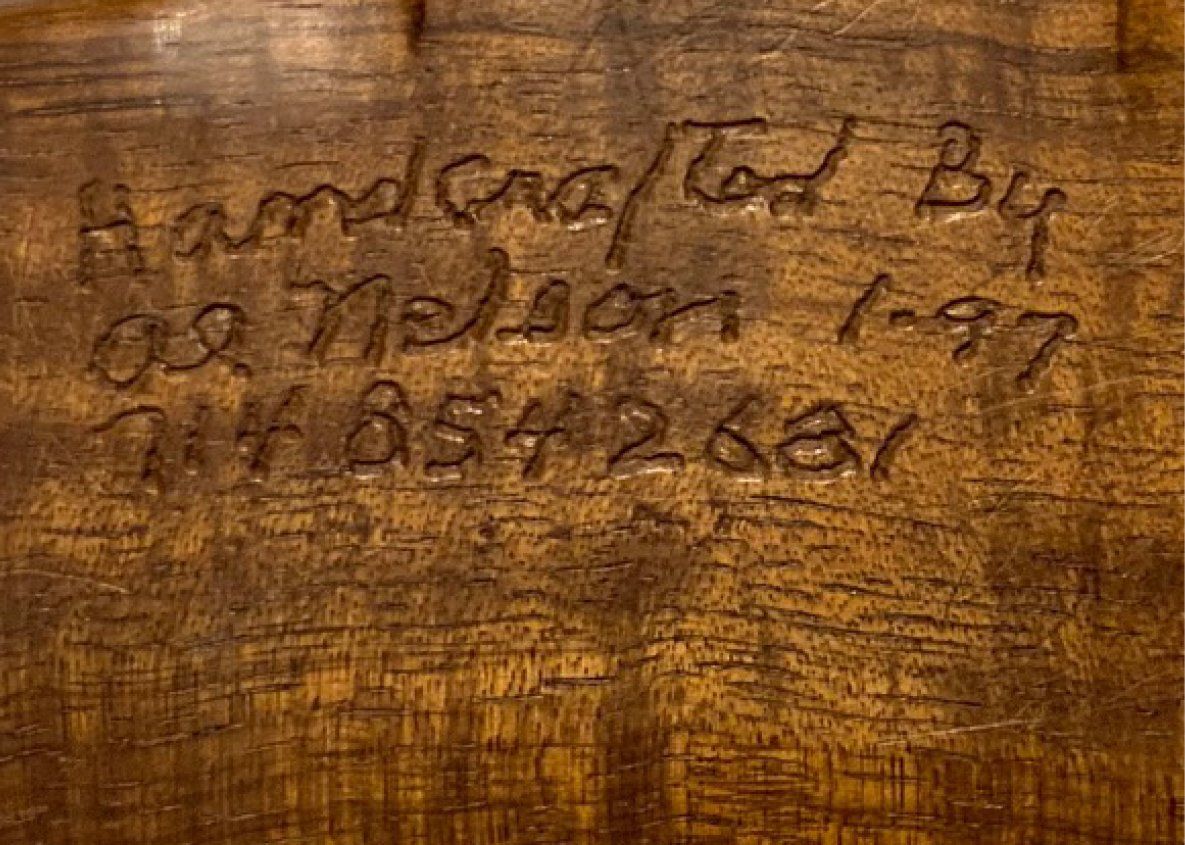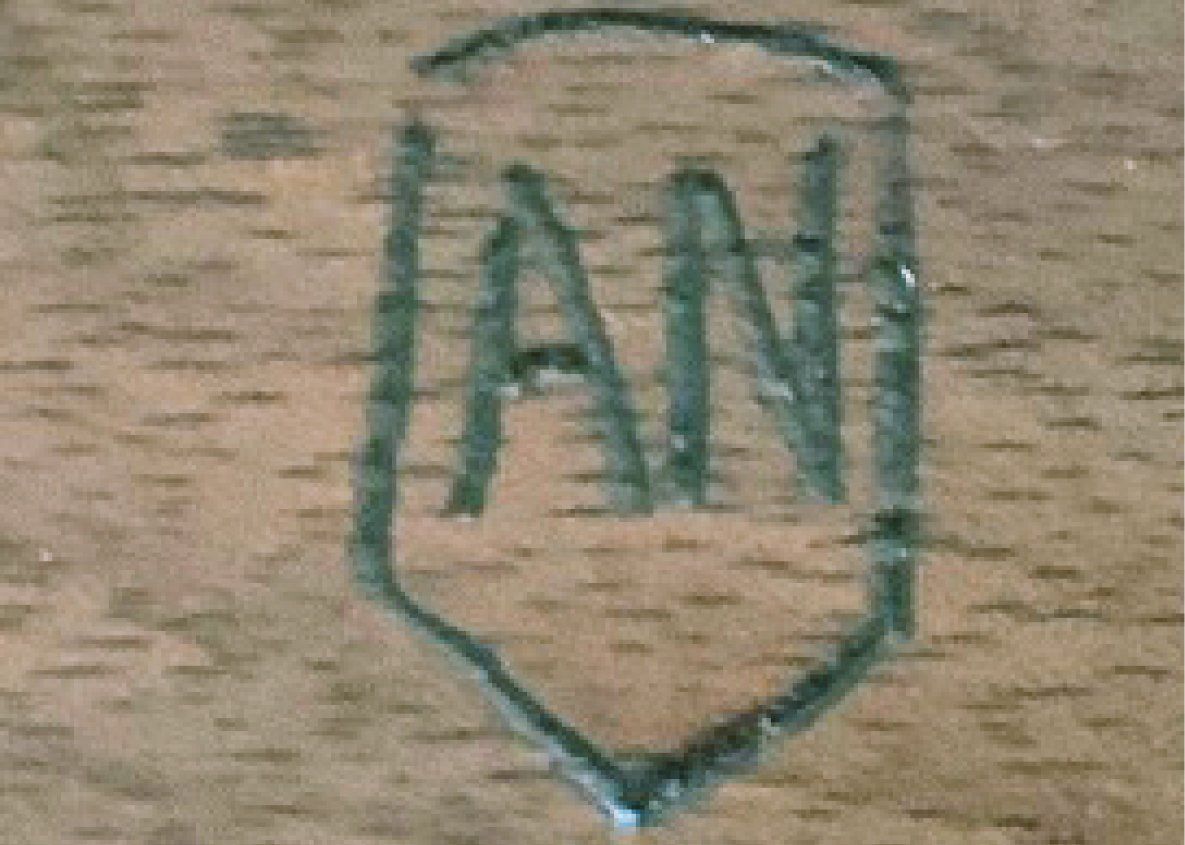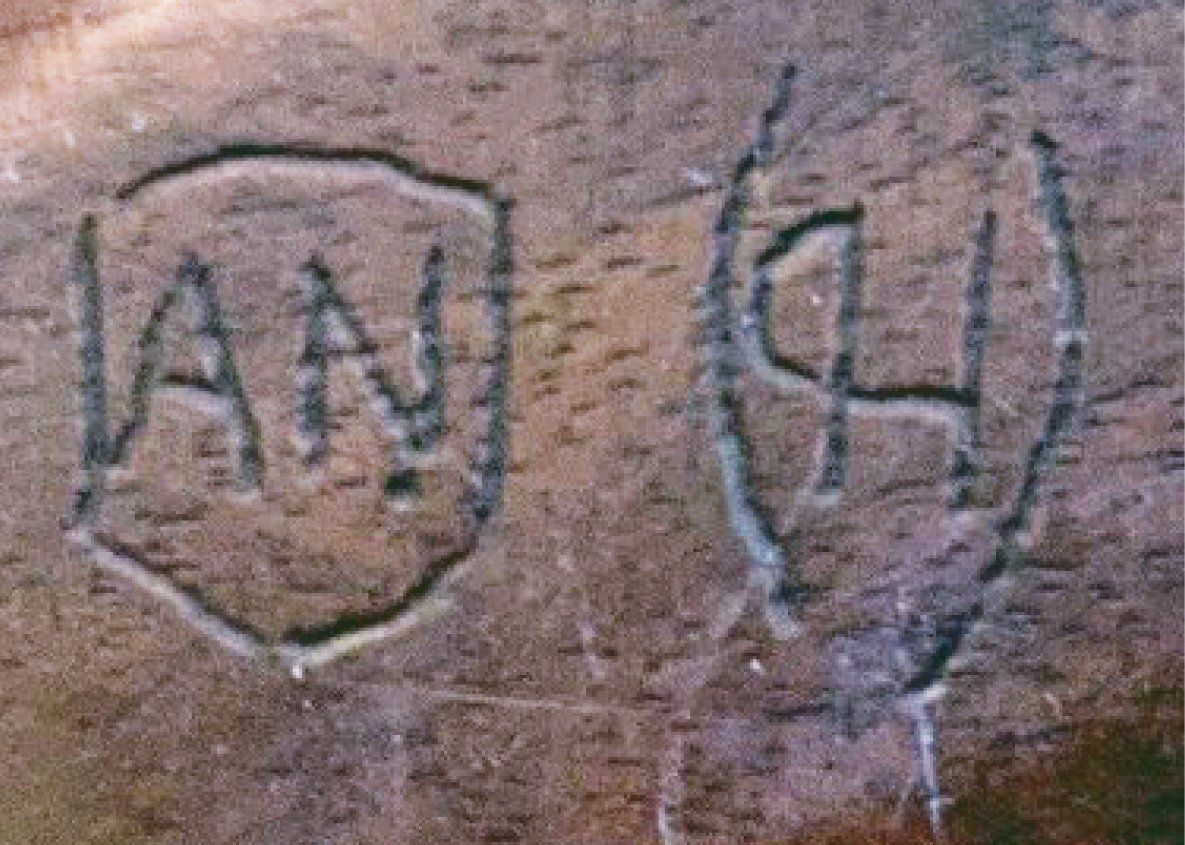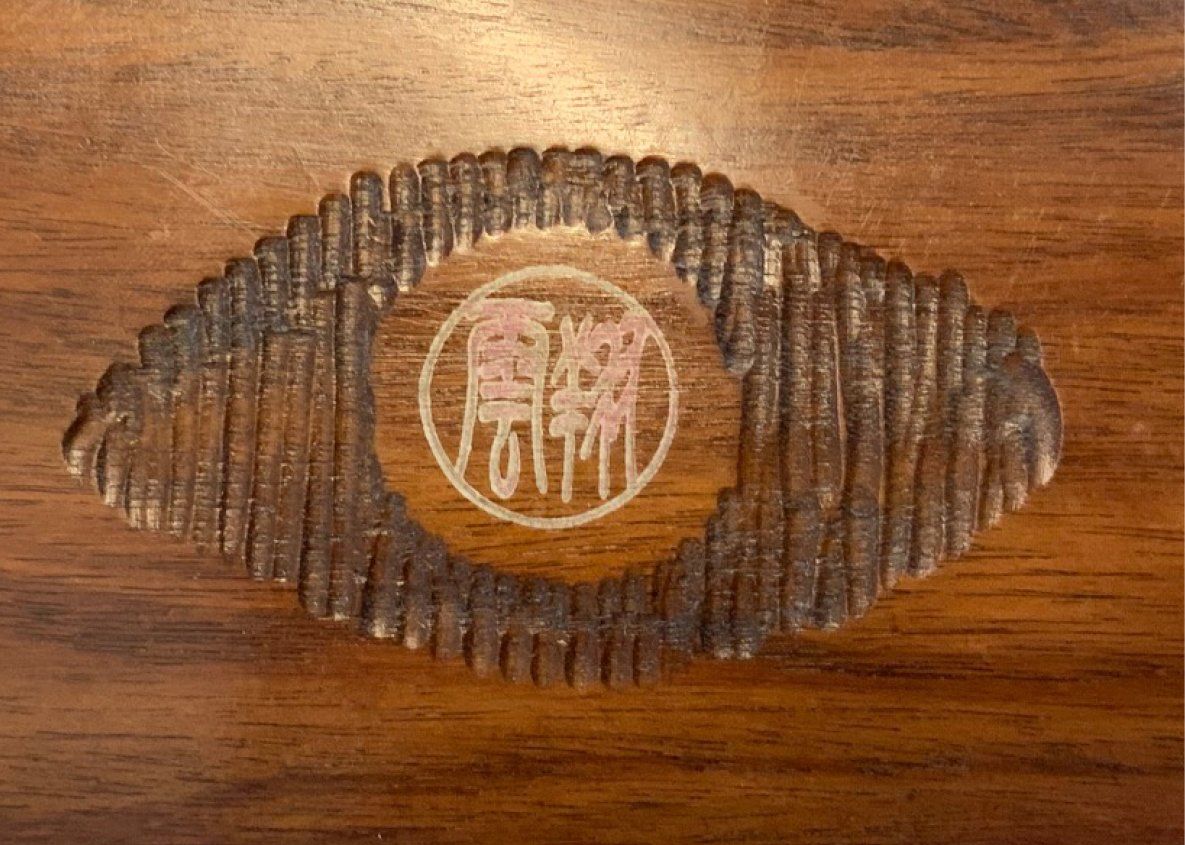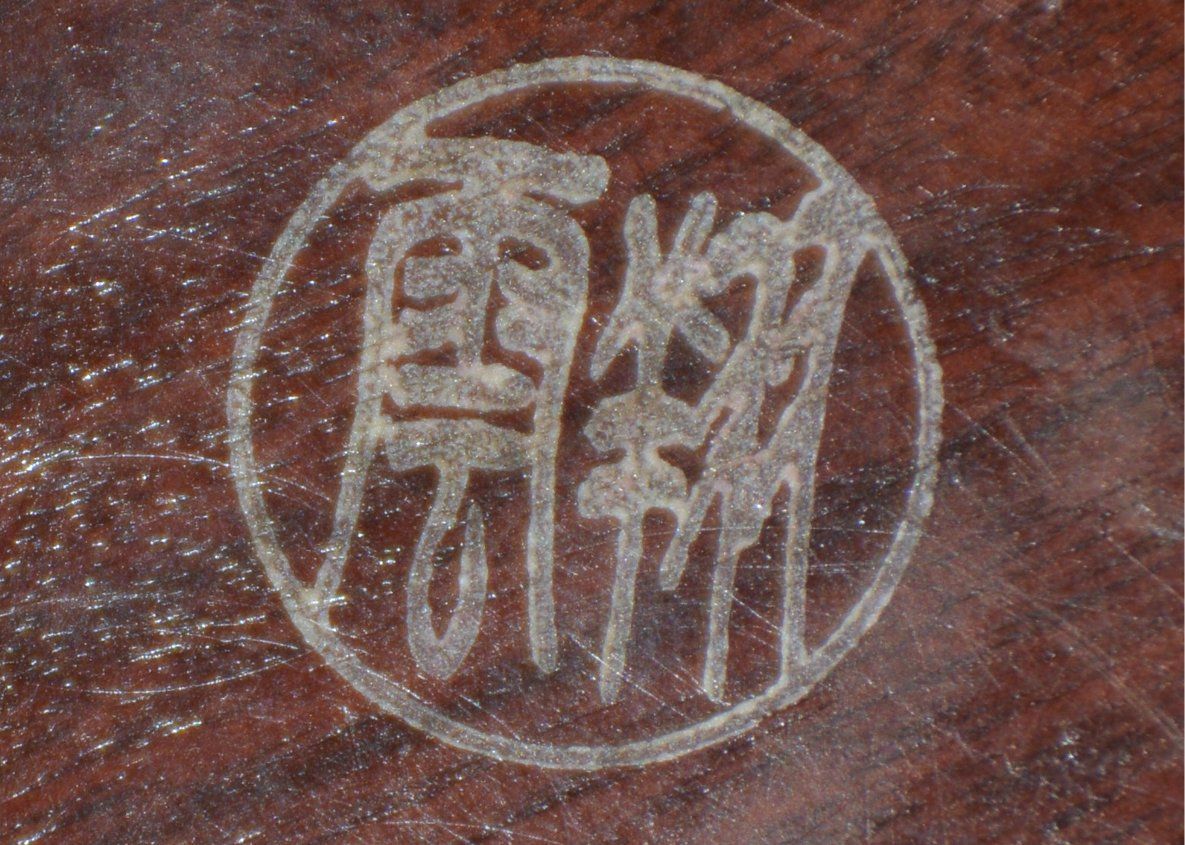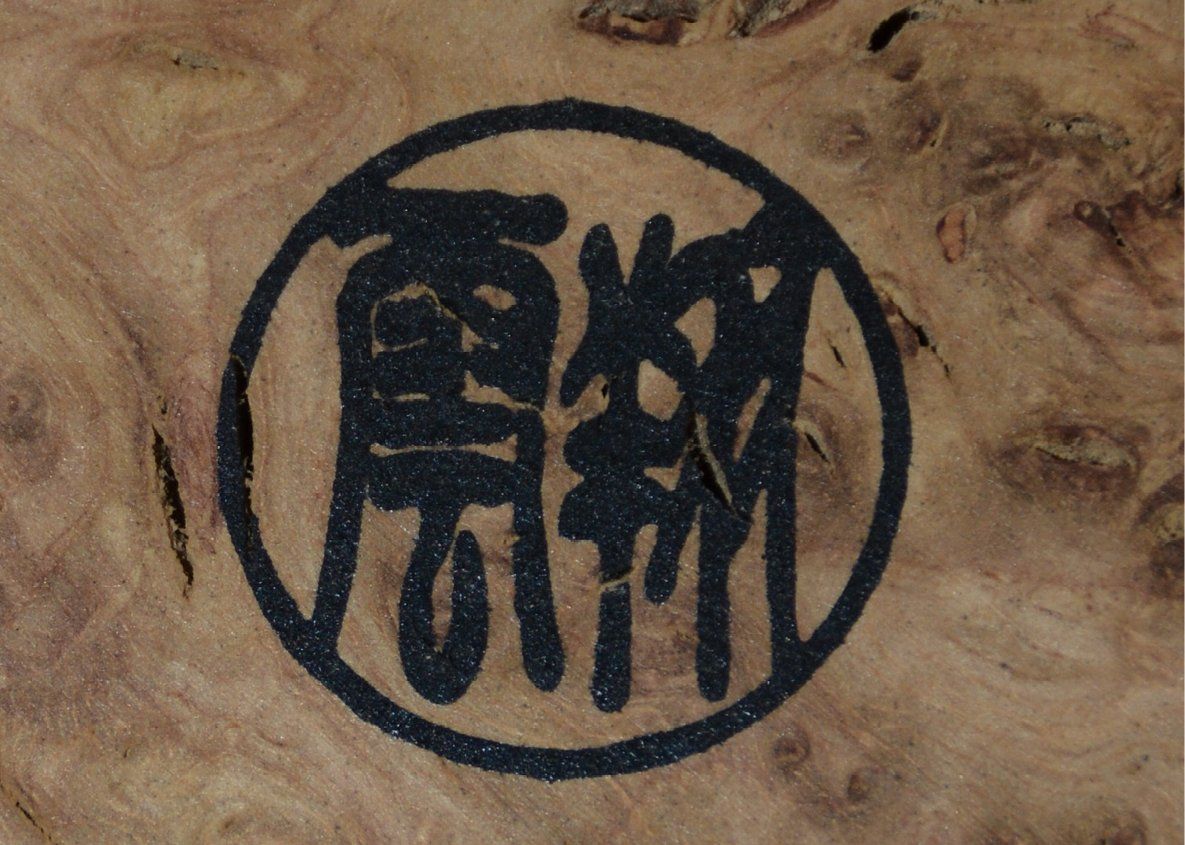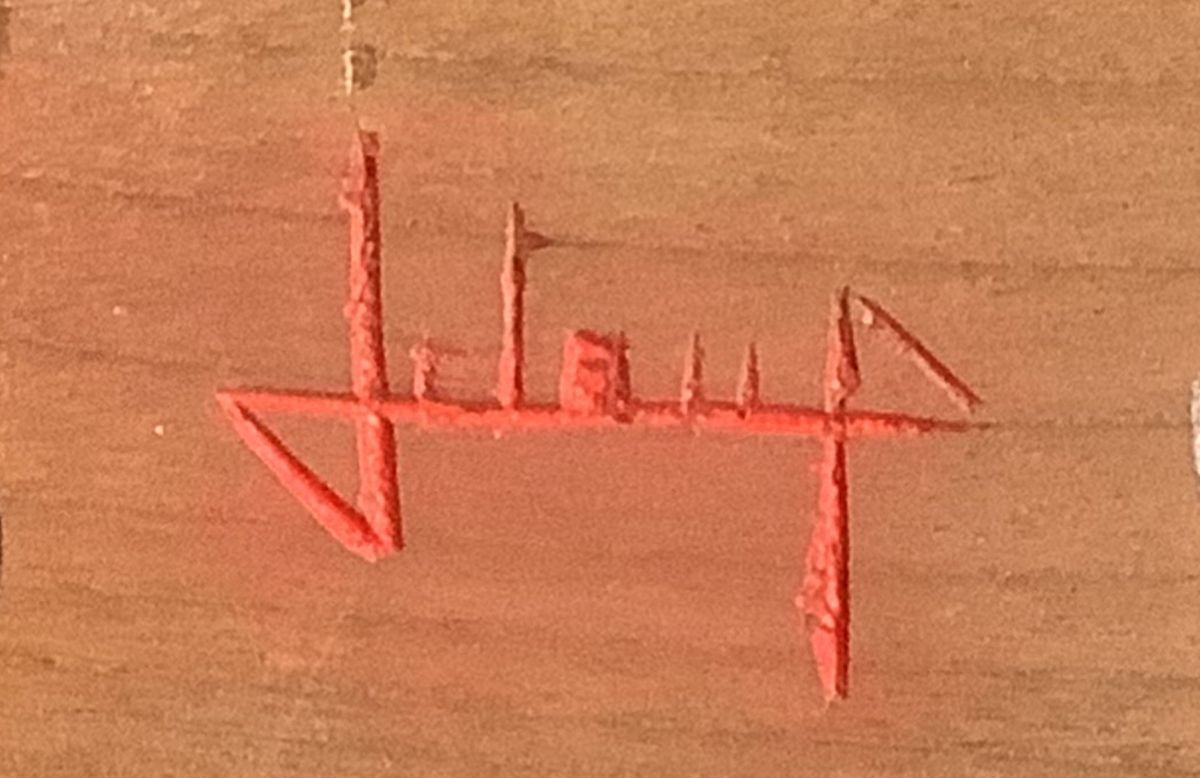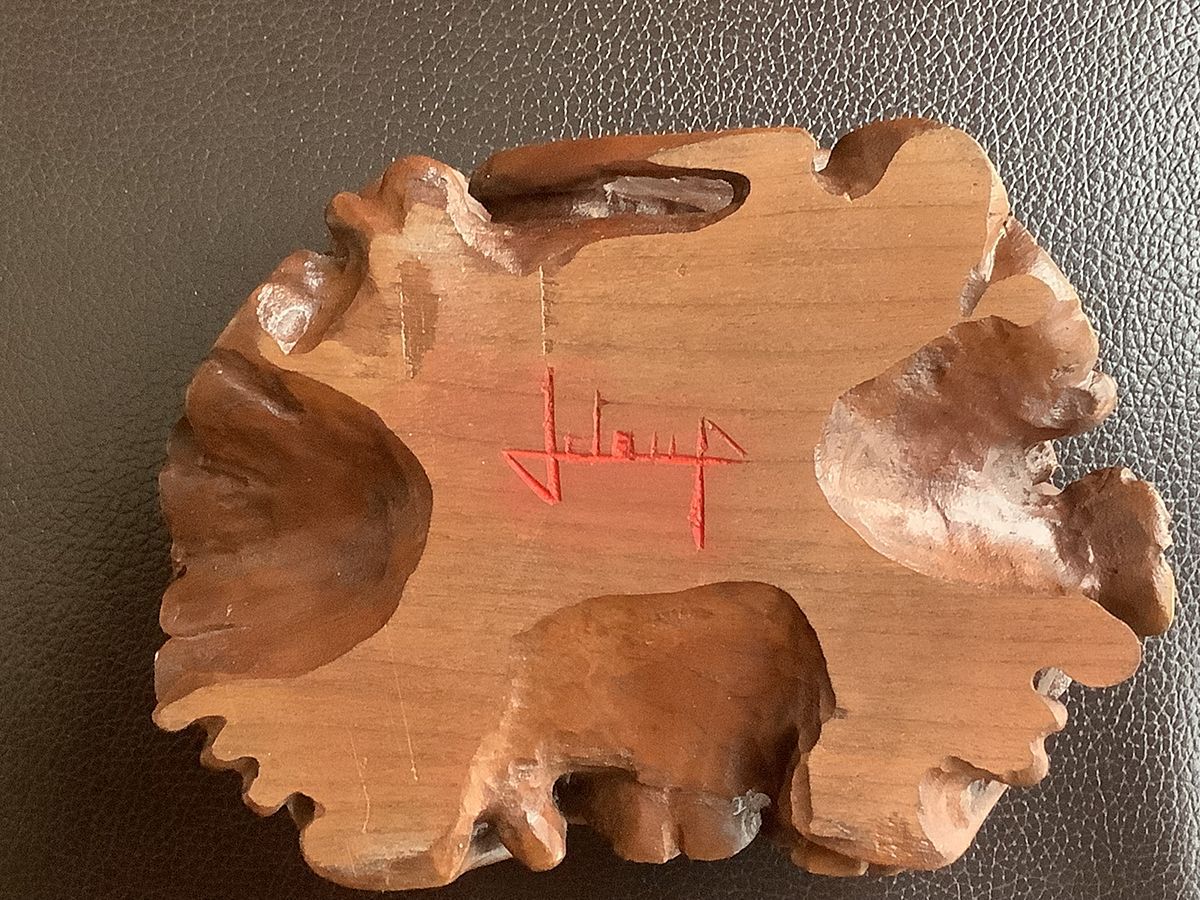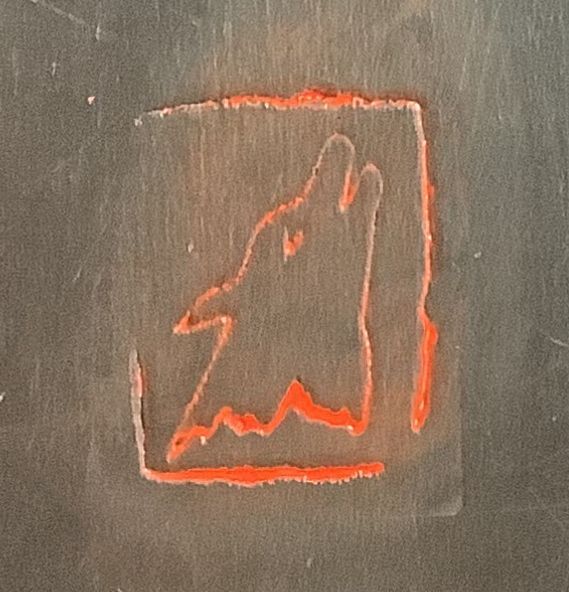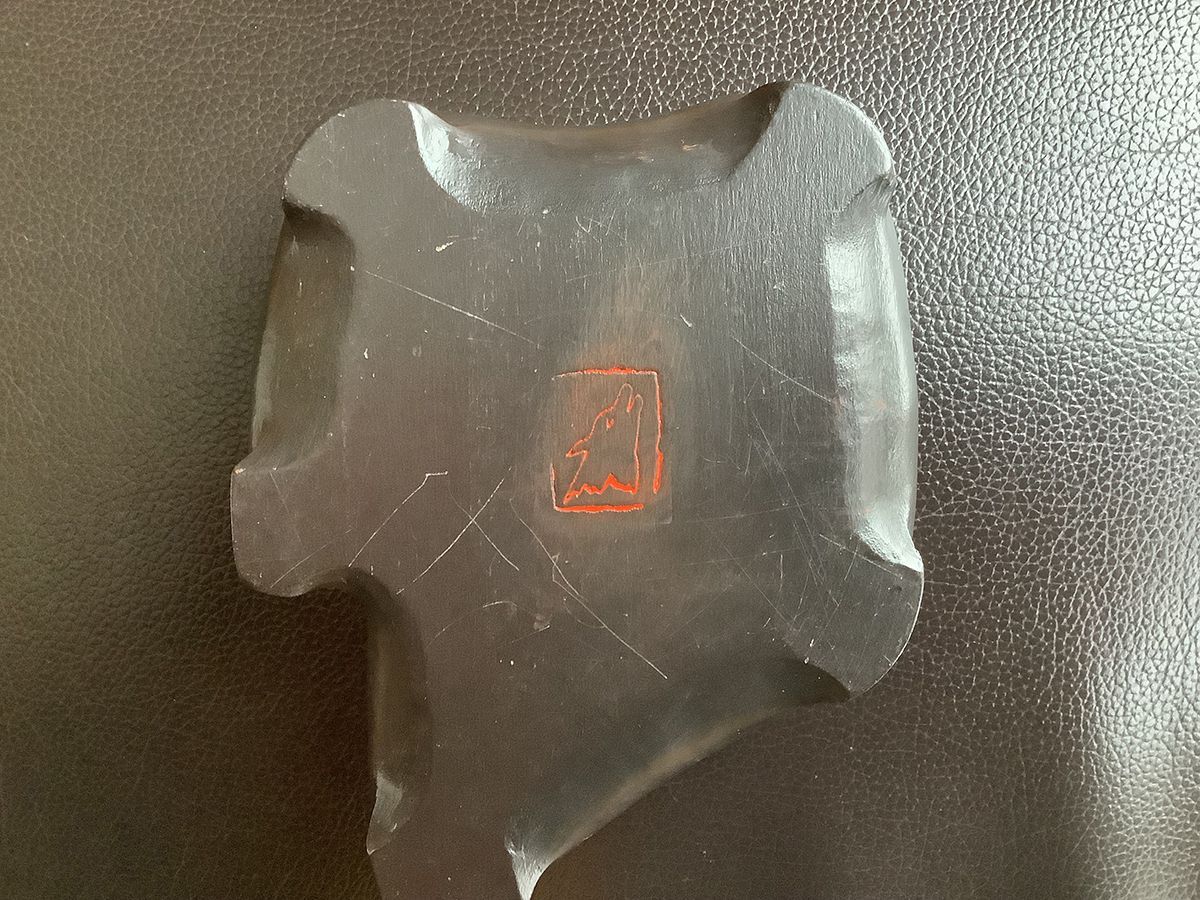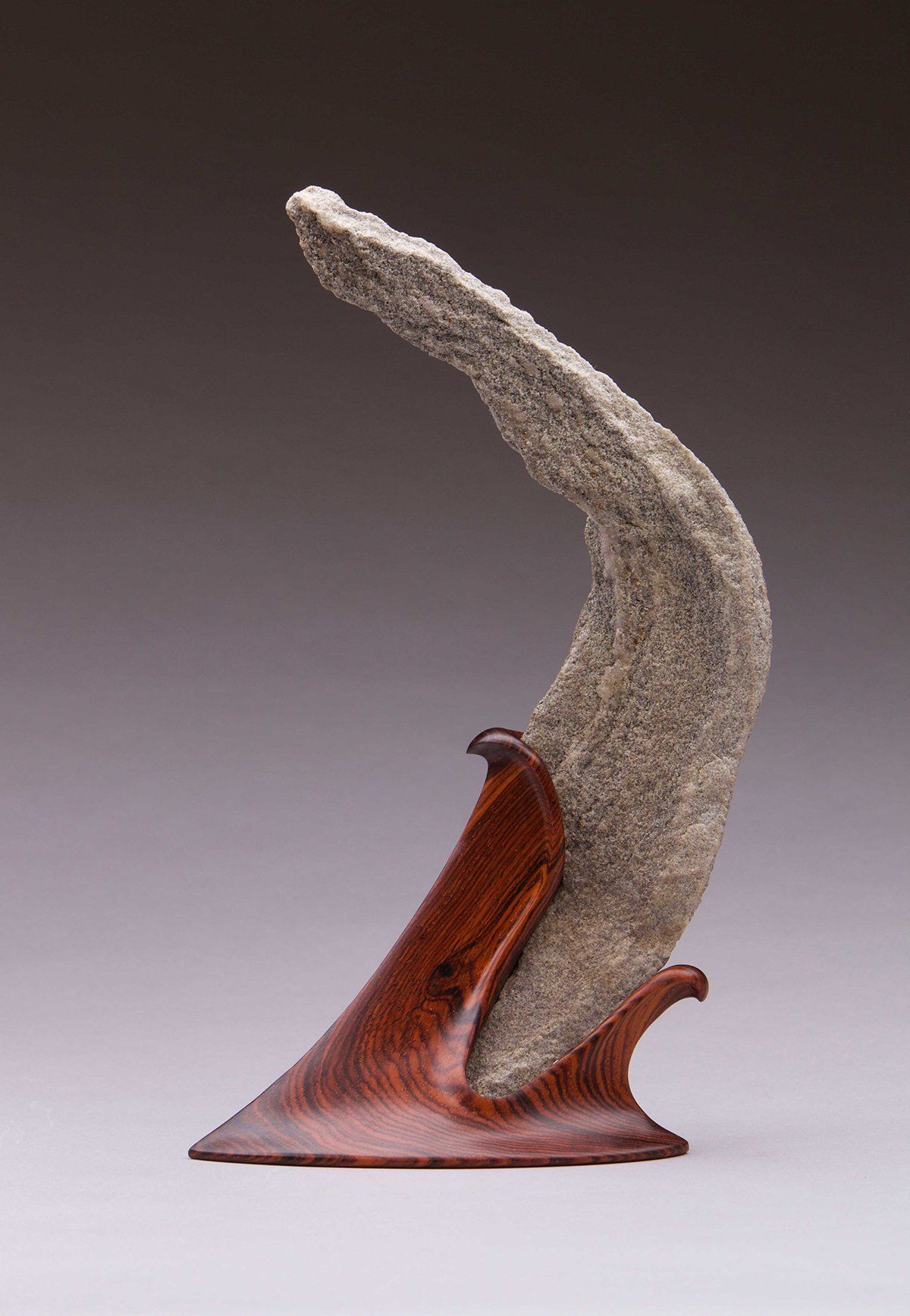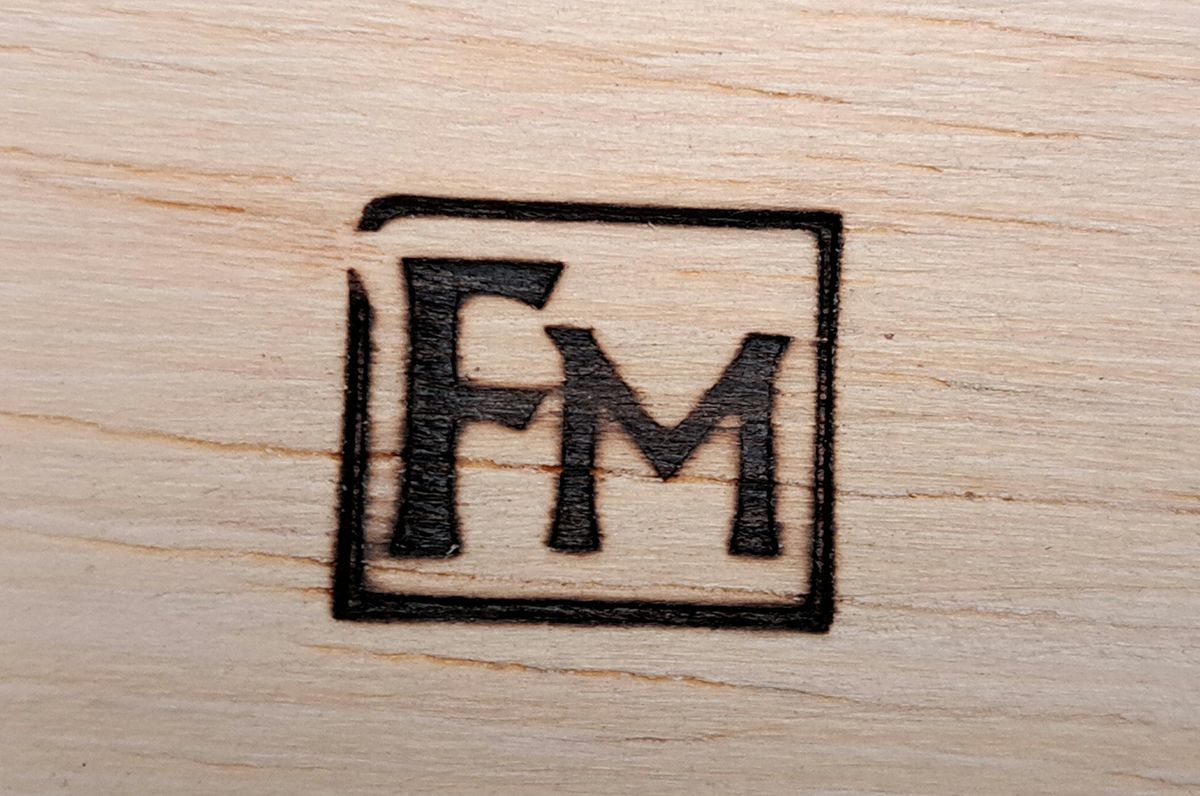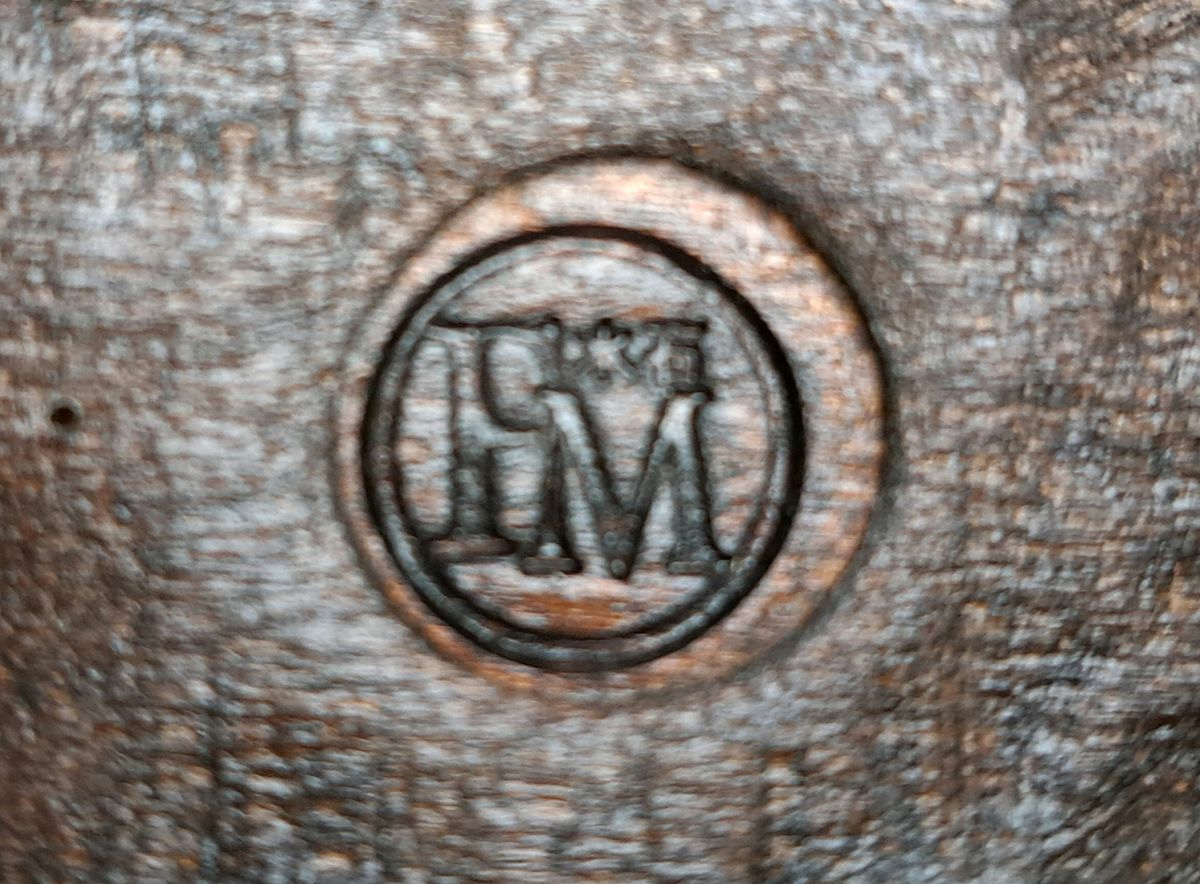Artists & Craftsmen: Signatures, Seals, and Trademarks
Nigel Atkinson
Home: Perth, Western Australia
Period of Activity: Nigel began making bases in 2013 and continues to the present. He makes approximately 50 bases per year for himself and for others, mainly in Western Australia. His goal is to promote the art of Suiseki in western Australia. He molds his daiza to match the surrounding edge and natural base of the collected stone. To identify the undulation of the base, he initially presses the stone into floral foam blocks and also uses carbon paper further along the track to see the rub-marks to identify where to carve further. Atkinson primarily uses powers tools, but uses hand tools for minor adjustments.
Preferred Wood: His favorite woods are from native Australian trees because they are easier to acquire. Among the ones he uses most are: Jarrah (Eucalyptus marginata), is a fine-grained hard wood with a rich dark color; Sheoak (Casurina equisetifolia), his favorite, is not as hard as Jarrad and has a beautiful patterned grain and polishes well; and Marri (Corymbia calophylla) and Blackbutt (Eucalyptus pilularis), but these woods are harder to acquire.
Signature: His signature or mark is a drawing of three mountain peaks on a base. The first two peaks resemble the letter “N” for Nigel, and the last peak resembles the letter “A” for Atkinson. This mark is 2 cm wide and 1 cm high. Nigel stamps with ink on smaller wood bases.
Felice Colombari
Home: Monza, Italy
Period of Activity: "I approached the world of susieki at the end of the 1990s. I started collecting stones, mainly in Liguria, and after a few years, I met other enthusiasts with whom I shared this passion. Little by little, I began to carve daiza and participate in exhibitions." Colombari has been carving bases for viewing stones for approximately 20 years. He is self-taught. Each year, he carves about 50 bases for himself and other collectors.
Preferred Wood: cherry, other woods used are pear, walnut, mahogany, koto and paduka.
Signature:
The name FELIX in capital letters with an arc above and below the letters. The signature is 2.3 cm wide and 1.4 cm high. He used a rectangular box around the name FELIX in his early bases.
Chin Shi Hong
Home: Shanghai
Period of Activity: Active. Chin began his study of wood carving when he was 16 years old and has been a professional woodcarver for forty years. He serves as the Vice-Chair of the Shanghai City View Stone Association, the Zhejiang Province Rose Wood Association, and the Jinhua City Arts and Crafts Industry. He is a certified China rosewood art master and certified Chinese traditional Art and Craft Master.
Chin has a display shop in the Hu Tai Road stone market in Shanghai where people can see a wide range of mainly more contemporary style Chinese bases on display. After studying a stone, he sketches and designs a custom base for each stone. He is an accomplished artist and creates a detailed design on paper before beginning any work on the base. The stone and his design are taken to another location where he has several craftsmen make the base.
Preferred Wood: Chin uses rosewood almost exclusively. His intricately detailed carving and skillful wood bending skills are excellent elaborate bases.
Signature: none, although Chin Shi Hong issues an attractive certificate of authenticity for the bases he designs and has made under his supervision.
Yvonne Graubaek
Home: Denmark
Period of Activity: Yvonne began carving bases in 2008 and continues to make bases for her stones to the present. Because of time constraints, she carves Japanese-style daiza solely for her stones. Graubaek has presented some of her friends with a stone and base as a gift. Thus, some of her bases are entering into other collections. She does not have a distinct style. Instead, she lets the form of each stone inspire the design, within the Japanese style. She has carved approximately 100 bases.
Preferred Wood: Yvonne preference is for Asian rosewood. This tropical hardwood has minimal grain features. She stains the rosewood to a natural-appearing dark color before applying a polish wax coating.
Signature: Her signature is written on the bottom of the data with a pen. Yvonne usually adds the name of the type of stone using Japanese terminology. Her real signature is the inside of the daiza."
Domenico Abate
Artist Name: Mimmo
Home: Roccavaldina (Messina), Italy
Activity in suiseki: Abate began carving wood bases for stones in the early 1990s. He has made over 200 bases for clients in Mexico, Brazil, Argentina, Poland, Denmark, Lithuania, and Italy. He is still carving bases. In 2020, Abate opened the Museum of Suiseki in central and southern Italy, where he served as artistic director.
Some of his works have also been directed to the production of Chinese bases (shizou) with designs that complete the stone instead of making the base minimal.
Preferred wood: He uses pear, cherry, teak, iroko, and walnut as his primary woods for making bases.
Signature: His signature is a square pad with two Japanese characters named “Mimmo Abate” underneath.
Cosimo Fragomena
Artist Name: KF
Home: Catanzaro, Calabria, Italy
Activity in suiseki: His passion for suiseki was born in 1999, but several years later, he began his studies as a student of Sensei Luciana Queirolo. This begins a path that led him to love the entire cycle of suiseki: from the search for the material (tanseki – ko) to the cultivation of the stone (Yo-seki) to the interpretation of the most suitable style of daiza and the stone, and finally, to make the base for the stone. For this reason, he is a complete suisekista.
Some of his works have also been directed to the production of Chinese bases (shizou) with designs that complete the stone instead of making the base minimal.
Preferred wood: Cherry, Walnut, and African Pear.
Preference: For display in tokonoma (toko-kazari).
Signature: it has a vertical "K" and an inverted and horizontal "F" on the bottom of the base.
-
City skyline
Photo By: John DoeButton
Carlo Maria Galli
Artist Name: Il Maremmano
Home: La Maremma Grossetana, Tuscana, Italy
Period of Activity: Galli has been carving bases for viewing stones since 1990 and has made approximately 100 bases each year. Galli is also a stone collector. His stones and bases have won several awards in Italy and Europe. Stones with his bases can be seen throughout Europe, and many have been sent worldwide. Galli has opened a studio where he teaches and researches the creation of bases. Galli uses a water-based product for staining wood in dark walnut or mahogany. He usually applies two or three coats. After staining, he uses a transparent acrylic spray stain and may finish with beeswax rubbing.
Preferred Wood: Galli uses beech (Fagus), walnut (Juglans), and cherry (Prunus) woods to carve his bases.
Signature: His mark consists of three initials of his name in a square or rectangular block.
Giorgio Rosati
Artist Name: None
Home: Genova, Italy
Period of Activity: Giorgio is an amateur base carver who occasionally makes smaller bases for individuals in Italy and abroad. He began making bases in 2011 and for his friends in 2014.
Preferred Wood: He prefers rosewood, but it is costly, and he uses it primarily for small and the most precious stones. Most of his bases are made from American walnut because it has good color and polishes well. Giorgio also uses pear (Pyrus) wood because it has a fine grain that is good for carving, but this wood is difficult to find in Italy.
Signature: Rosati’s signature is two mountains with slight variations. The symbol is about 1.5 cm x 0.8 cm.
Harada, Kazuya
Artist Name: Kazu
Home: Nagoya, Aichi prefecture, Japan
Period of Activity: He started making daiza in the mid-1970s, and for many years he carved bases exclusively for suiseki dealers in Nagoya. One of his main dealers was Tanigawa-en. As the number of dealers declined in Nagoya, he began making bases for individuals. In the last decade (2010-2020), Harada has made superior bases for higher-quality stones in Japan. Many consider Harada to be the premier base carver in Japan since the early 2000s.
For more information, see the feature article Harada Kazuya, Japan’s Master Daiza Carver, on the www.vsana.org website for February 2020.
Preferred Wood: Harada uses rosewood almost exclusively. After sanding, he hand rubs a Chinese lacquer paste on the base. This is repeated two or three times.
Signature: When he began making daiza, he used three characters (Kazuya), but later, he shortened it to two characters in a horizontal orientation.
Hotomi, Junzo
Artist Name: Sansai
Home: Tanabe in Wakayama prefecture, Japan
Inactive: Hotomi Junzo was active from the early 1960s to approximately 2018. As a teenager, Hotomi studied woodworking and began his career as a cabinet maker, especially those used in the tea ceremony. As the demand for tea ceremony cabinets declined, he made finely carved bases primarily for Furuya stones. He is also well known for his craftsmanship and making excellent double boxes. Hotomi signs his daiza on the inside; however, he doesn’t sign all of his bases, only those he considers superior.
Preferred Wood: Hotomi uses rosewood or zitan wood for bases depending on the stone’s quality. He also used Paulownia wood to make some bases. His storage boxes are made of Paulownia for the inner box and mulberry wood for the outer box.
Signature: His signature consists of fine lines in a vertical orientation and on a smooth, polished pad about 3 x 2 cm.
Otani, Hideo
Home: Tokyo, Japan
Period of Activity: Otani has been making daiza for Japanese stone for 25 years
Preferred Wood: Rosewood, Red Sandalwood, or Ebony
Signature:
unknown, maybe his bases were not signed
-
City skyline
Photo By: John DoeButton
Saito, Hiroshi
Artist Name: Hiroshi
Home: Tainai City in Niigata, Japan
Period of Activity: Saito began carving bases for Japanese stones in the early 1990s and is still active today (Spring, 2023). For many years, he made bases for the late Kasahara Manabu, a leading Tokyo stone dealer and Nippon Suiseki Associate board member. He learned some daiza carving skills from the late Suzuki Koji, and further refined his wood carving ability with Harada Kazuya.
Preferred Wood: Saito used Osmanthus wood initially, then changed to Rosewood.
Signature: Initially, Saito used his given name, Hiroshi, as his signature on his bases. Later, he changed his mark to read “Hiroshi made.” He would also add the source of the stone when requested by the owner. The sample below gives the name “Kamo River” left, and his signature “Hiroshi made” on the right.
Suzuki, Koji
Artist Name: Koju
Home: Hamamatsu, Shizuoka Prefecture, Japan
Inactive: The late Suzuki Koji, artist name Koju, was active for 50 years (1966 through 2016) as a daiza carver. Suzuki studied with Tanimoto Hyakusui. During his career, Suzuki made an estimated 9,500 bases. He was one of the most prolific base carvers in Japan and was considered by many to be the best daiza carver in Japan during the peak of his career.
Preferred Wood: He preferred red sandalwood and used recycled red sandalwood when available.
Signature: He has consistently used the same signature throughout his career. The very fine lines are characteristic and difficult to duplicate. His signature “Koju” consists of two characters arranged in a vertical position. It is 2 cm by 1 cm and usually does not vary.
-
City skyline
Photo By: John DoeButton
Tanimoto, Hyakusui
Artist Name: Sekiyusai
Home: Kii Tanabe, Wakayama prefecture, Japan
Period of Activity: Tanimoto was the leading daiza maker for Furuya stones. He is known for his more elaborate detailed daiza with low scroll feet than most other Japanese base carvers. He was active from the 1950s through the 1970s.
Tanimoto was the leading daiza maker for Furuya stones. He is known for his more detailed daiza with low scroll feet. His bases are more elaborate than those of most other Japanese base carvers. He was active from the 1950s through the 1970s.
Tanimoto is the co-author of the book Furuya Famous Stones, Comprehensive Illustrations (1969).
Status: Deceased
Preferred Wood: unknown
Signature: Tanimoto used at least two versions: his name Hyakusai and the other was his artist name Sekiyusai. Both are presented in vertically oriented characters.
Usui, Tadashi
Artist Name: Suifu Sanjin
Home: Mito City, Ibaragi Prefecture Japan
Period of Activity: Sanjin (1921-1994) was a student of Katsuragi Kohzan, a famous craftsman. He made his first daiza in 1951, and created over 200 bases in his life. Sanjin believed that daiza should have an odd number of feet, usually 3, 5, or 7. He als believed that the base serves a supporting role and should enhance the goodness of a stone. The diaza should not be the main feature of a stone/base display. Sanjin believed that a daiza maker should show his skills in a subtle and hidden way and be humble and self-disciplined. He specifically recommended that long-distance mountain stones have a thin or shallow base with small legs. Sanjin assembled a fine collection of natural Suiseki and ceramic pots and trays.
For more information about this Suiseki connoisseur, see the Japanese language book The Retrospective Exhibition of Suifu Sanjin (2001) by Morimae Seiji.
Preferred Wood: Unknown
Signature: His signature is a four-character vertically arranged signature without a border.
-
City skyline
Photo By: John DoeButton
Yoshida, Yukihiro
Artist Name: Yoshida Bonseki
Home: Fukagawa, Hokkaido Japan
Period of Activity: Yoshida was one of the most active stone collectors on the northernmost main island of Hokkaido. He collected over 1,000 stones and made all of the daiza for his stones. He is not known as a professional base carver. Still, Yoshida is included in this database because many stone collectors prize his numerous smaller rocks. Many of his stones with bases are in the hands of European and North American stone collectors. Yoshida serves as the President of the Fukagawa Kotan Suiseki Association for a period.
Preferred Wood: Yoshida primarily used the softwood of the native Hokkaido Tilia tree. He thought that the base has to be in a supportive e role to the stone and that a daiza can make a stone display better or worse depending on the quality of the base.
Signature: Yosida’s signature consists of the name “Yoshida Bonseki” in a vertical orientation when the daiza was large enough to accommodate the characters. On smaller-sized bases, he used just the word “Bonseki.” Another variant is the characters for “Yoshida” side by side with those for “Bonseki.”
Sandro Tschudin
Artist Name: None
Home: Hämikon, Switzerland
Period of Activity: Current. Tschudin specializes in high-quality hardwood bases and produces a limited number of bases each year. He began making bases for his collection several years before he started carving bases for others in 2015. He has made over 255 bases for others. The Chinese style initially influenced Tschuden to develop his own style of more naturalistic, free, and western expression. His goal is to find the balance between enhancing the features of the stone and his own creative inspiration. Tschudin graduated from art school in Zurich. Daiza making is his passion.
Preferred Wood: For projects that require more detailed carving, he prefers dense tropical hardwoods when available because the harder woods allow for intricate work. Most of these woods are no longer available in the commercial trade. Tschudin uses a variety of woods to match the color and grain of the wood with the color and texture of the stone. He doesn’t stain or varnish his bases. As a result, he uses a greater variety of woods than most base carvers. These include Gonbeira (Swartzia stipulifera) and ebony (Diospyros spp.), different species of Dalbergia, Mahogany (Swietenia macrophylla), and others.
Tschudin used thermally modified native European woods, oak (Quercus), beech (Fagus), and chestnut (Castanea), for bases that have less detail. These thermally treated woods are physically stable and exhibit attractive dark tones. He likes to experiment with these modified woods. These woods are physically stable and exhibit attractive dark tones. He likes to experiment with these modified woods.
Signature: Three-character vertical signature consisting of three Japanese characters “Sa” + “ch” + yu” representing his family name Tschudin.
-
City skyline
Photo By: John DoeButton
Jerry Braswell
Artist Name: None
Home: Pine Grove, California, USA
Period of Activity: (current): Jerry is a skilled woodworker who began making daiza in 2005 for uncut and cut stones, minerals, and fossils. Braswell also makes quality display tables and Japanese-style Kiri-Bako for viewing stones. He has made more than 3,000 bases for many North American collectors. Jerry is one of the most prolific base makers in the United States.
Preferred Wood: His primary wood for bases is the black walnut; however, he loves rosewood, other exotic tropical hardwoods, and burl wood. He also makes painted softwood bases when requested.
Signature: His signature consists of the letters J and B linked together with a diagonal slash mark above the two letters. The mark is approximately 1.2 cm X 1.8cm.
Phil Hogan
Artist Name: None
Home: Monrovia, California, USA
Period of Activity: Phil began an apprenticeship with Al Nelson in January 2014. After his training, he has continued to carve bases for many collectors, particularly in California. He has made more than 450 bases by the end of 2021. Phil is an experienced woodworker who also makes display tables for stones and bonsai.
Preferred Wood: He uses Black Walnut, but he also makes painted, soft basswood bases (Tilia) on request.
Signature: A vertically oriented signature consisting of the letters “P” and “H” combined into a single character with a wavy line on each side. The shape of the wavy line may vary somewhat. The size of the signature varies in size and maybe 2.5 cm (1 inch) to 1.75 cm in height and 1.5 to 1.2 cm (0.7 to 0.5 inches) wide.
Edd Kuehn
Artist Name: None
Home: Seattle, Washington USA
Period of Activity: Active: Kuehn began carving bases in 2010 and continues to do so. Kuehn, who has made approximately 200 bases, is an avid stone field collector in the Pacific Northwestern US and has displayed his stones and bases in many exhibitions at the Pacific Bonsai Museum " Stone Images" He is a long-time member of the Viewing Stone Study Group of the Puget Sound Bonsai Association and California Aiseki-kai.
Preferred Wood: His primary wood for bases is the American black walnut, but he has also carved Koa, Maple, Indian Rosewood, Peruvian Walnut, and many others, discovering unknown allergies along the way.
He likes to use Gabon ebony in a continuing series, Black on Black, with black northwestern mountain stones. Kuehn likes two wall bases on mountain stones and feels that bases help embellish the stone. He has carved large and small with an affinity for small-size bases.
Signature: His current mark, about 2 inches (5 cm) long, is a bold script, Ekuehn, of his name and year in gold-colored ink on the bottom of the base His earliest bases have his black ink signature inside the base.
Patrick Metiva
Artist Name: None
Home: Renton, Washington, USA
Period of Activity: Patrick has been carving bases commercially since 2013. He has carved over 100 bases for clients.
Preferred Wood: is Madrone (Arbutus menziesii), but he also uses Cocoloba, Rosewood, and Black Walnut (Juglans nigra). He can make bases in the Japanese and Chinese styles.
Signature: His signature is found on the inside of the base. It is a cursive signature of his name and date. If room allows, Metiva also indicates the type of wood used to make the base.
Al Nelson
Artist Name: None
Home: Irvine, California, USA
Period of Activity: Active: Al Nelson began making bases for viewing stones in 1992 and continued for the following 30 years. He is the leading base maker in southern California and has taught many people how to make bases. Nelson has made over 1,000 bases for many stone collectors.
Preferred Wood: Al’s preferred wood for a base is walnut, although he also uses cherry and popular woods.
Signature: Nelson used “Crafted by Al Nelson” in cursive when he first began making bases but later shifted to a shield with the initials “AN” inside the shield. There are many bases in circulation with dual signatures “AN” and “PH.” These are bases made jointly by Al Nelson and his student Phil Hogan.
Sean Smith
Artist Name: None
Home: Marysville, Pennsylvania, USA
Period of Activity: Sean began carving Japanese-style bases in 1994. He also makes display tables and storage boxes (Kiri Bako) and builds tokonoma for clients. He has made several thousand bases.
Preferred Wood: Indian Rosewood, Black Walnut
Signature: Smith has used several variations of his mark over his career as a base carver. The earliest ones consisted of a large seal with his given name, but the signature became smaller and consisted only of two Japanese characters over time.
Pierre Laloup
Artist Name: None
Home: Québec, Canada
Period of Activity: Laloup is an artist and designer inspired by traditional Japanese aesthetics. He specializes in interior and commercial designs, Japanese gardens, ceramics, and woodworking in traditional Japanese minimalist layouts. He is a self-taught woodworker who has made shoji doors, transoms, decorative figures, bonsai tables, and bases for viewing stones for the last 20 years. Each year, he makes about a dozen carved wood bases for himself and his clients.
Preferred Wood: He prefers to use local woods, including ash, cherry, walnut, and oak. Laloup has also used mahogany and wenge.
Signature: He used his familial name, Laloup, in his earlier works before changing to an outline of an upright wolf’s head within a box. His early mark is 3 x 2 cm, while his animal figure mark is 2.5 x 2 cm.
Tony Ankowicz
Artist Name: None
Home: Madison, Wisconsin USA
Period of Activity: Tony collected stones for over 30 years before discovering the art of viewing stones. His first bases emulated Japanese daiza, but subsequent bases quickly evolved into a more contemporary interpretive. He is known for his innovative carving skills. Tony has only made a limited number of bases, about 50. His contemporary interpretive style is in response to the types of stones he was trying to seat in a carved wood base.
Preferred Wood: His preferred woods are the American black walnut, Cocobolo, and occasionally some Central American rosewoods
Signature: Initially, Tony used an inscription of his initials. Then, it evolved into a stylized relief of his initials which eventually became his current single mark.
Franco Mauri
Artist Name: Frank Paperino
Home: Monza, Lombardia, Italy
Background: My meeting with Felice Columbari in 2009 was decisive in becoming part of the world, where I began to collect stones and carve daiza. Driven by curiosity and a passion for the mountains and my work as a carpenter, I began to carve daiza.
Today, I have a collection of about 100 suiseki, some coming from other parts of the world. I produce about 70 bases a year for both myself and collectors. I also make kiribako in kotò for my stones. Each kiribako is numbered. I am currently on number 78.
Preferred Wood: cherry, walnut, rosewood, padauk, kotò
Signature: Franco used two types of signatures. The first is a rectangle measuring 2 x 1.5 cm and containing the letters “F” and “M.” Since 2016, Franco has used a circle measuring 1.5 cm in diameter, also with the initials “FM” inside. Two small Japanese characters for the word “suiseki” are placed above the “M” in the circular signature.


